
The Laser is the world’s most popular adult racing class boat. True to box one design standards, each Laser in the world is identical ensuring the best sailor on the water wins the race, not the boat. The Laser is a challenging boat that rewards athleticism, subtle steering and trimming techniques, as well as the tactical excellence of the sailor. The Laser has been raced by young and old alike from the Club level all the way to the Olympics. It comes in 2 different hardware versions XD, for racers and the ones looking for a more thrilling sailing experience and the Race, more suitable for the leisure sailors and club racing. Each hardware version has 3 rig possibilities, the Standard , the Radial and the 4.7 for the heaviest/more athletic to the lighter and younger sailors.
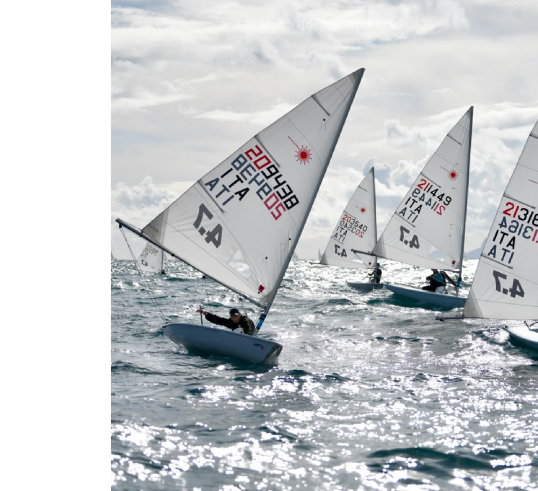
The world’s premier racing dinghy. The Weekender (name of the first prototype), with “TGIF” (Thank God It’s Friday) on the sail was designed in 1969 and quickly revolutionized the racing world with its speed and simplicity. It was called Laser in November 1970 and the production started the same year. It was launched at the New York Boat Show, its uniform design and affordable price attracted sailors and 144 Lasers were sold. Laser sails were identical due to modern laser cutting thus setting a standard for future racing classes. Today this timeless design is by far the most popular adult and youth racing boat worldwide. It is raced by many of the world’s top sailors and has been an Olympic class since 1996. The Laser’s full size rig rewards athleticism and is best for heavier, more experienced sailors, but it can easily be converted to a Radial or 4.7 by changing just the sail and bottom spar. When you race a Laser, one hull goes a long way. Just changing the lower mast and sail, you can convert any boat from Laser to Radial to 4.7. The advantage of this interchangeable formula is that you can easily switch boats as you become older, heavier or more experienced. Each rig helps you prepare for the next, so you get a step-by-step progression that can take you all the way from a beginning racer to World Champion!

The Laser has 2 hardware versions and 3 different rigs. Each uses exactly the same hull and foils, by lower mast and sail will make it suitable for a wide variety of sailors. This offers a unique step-by-step progression that makes it easy to switch models as a sailor change in age, ability or weight.

Two hardware versions to fulfill every sailor needs
- XD – For the ones looking for more performance – Carbon Fibre Upper Mast – Carbon Fibre Tiller and Extension – LaserPerformance Vang
- Race – For Recreational Sailing or Club Racing – Aluminium Upper Mast – Aluminium Tiller and Extension – Holt Vang
Three rig versions to suit every sailor
- Standard – 7.1sqm sail for heavier and more athletic sailors
- Radial – 5.1sqm sail for women, and lighter sailors
- 4.7 – 4.7sqm for youth and lighter females
The Laser is a true sailing phenomenon
With nearly 200,000 boats in 140 countries, it is clearly the world’s most popular adult and youth racing sailboat. Each year the Laser Class runs more races worldwide than any other class. And it’s still going strong! For almost four decades, the Laser has been a sailing success story. One reason is the boat’s sheer simplicity. From its very beginning, the Laser has offered an uncomplicated way for sailors to experience the joy of sailing and the thrill of competition. Many other qualities combine to make the Laser a legendary performer.
Effortless design
The Laser was created to get sailors on the water with minimal fuss. It has a lightweight hull that’s easy to carry and cartop. The two-part free-standing mast and sleeved sail make the boat easy to rig. And the simple layout means sailing is a breeze.
Strict One Design
The Laser is one design boat like no other. The class association is very strong and has strict class rules, so every Laser around the world is identical. This means races are won by sailing ability, not by equipment advantages.
Interchangeable formula
The Laser comes in three distinct models – the full-rig Laser, Laser Radial and Laser 4.7. Each uses exactly the same hull and equipment, except the sails and bottom spar can be changed to fit a wide variety of sailors. This offers a unique step-by-step progression that makes it easy to switch models as a sailor change in age, ability or weight.
Racing pedigree
Because Lasers are simple and identical, they provide exciting competition and a great chance to develop racing skills. Many of the world’s top sailors come through the Laser ranks, and both the Laser and Radial are current Olympic classes. No sailor is too inexperienced or too advanced to race a Laser. That’s why Lasers last a lifetime.
Superb value
The Laser’s simplicity, popularity and one design nature make it very economical. The Laser Class limits and controls go-fast extras, thus the boat will never be outdated, which explains why Lasers have such a high resale value. Whether it’s a local club race or the World Championships, every Laser has exactly the same chance of winning. And a young sailor can go all the way to the top of the sport in the same hull. That is Laser’s simple formula for success.
75.99 ft 2 7.06 m 2
13.78 FT 4.20 M
4.56 FT 1.39 M
2.62 FT 0.80 M
130 LB 58.97 KG
Beginner->Expert
Club->International
BOAT LIGHTNESS
TIME TO WATER
SKILL LEVEL

62 ft 2 5.76 m 2
13.78 FT 4.20M
50.59 ft 2 4.70 m 2
PARTS LOCATOR
RIGGING MANUAL
- Parts & Accessories
Privacy Overview
Free Shipping Over $99* - 366 Day Returns - Dedicated Customer Support

- Call Us +1-503-285-5536
- Sign in & Register
- Recently Viewed
Restoring & Upgrading Laser Sailboats - Advice & Common Questions

Over 200,000 Laser sailboats have been built over the last 40 years, more than most other small dinghy sailboats. In this article we are going to answer some of the common questions we receive about the basics of Laser sailboat rigging, how to tell what size rig you have, what you can upgrade, and more. This information is designed for the recreational sailor who is simply looking to replace missing parts or install simple upgrades that make it easier to enjoy their boat.
As a note, we're going to make frequent reference to a rigging manual put together by Vanguard Sailboats about 10 years ago. We still refer to this guide often as it shows two different styles of rigging side by side, which is particularly helpful if you have an older boat you wish to upgrade.
You can view that rigging guide here: Laser Rigging Guide (opens in new tab)
What size rig do I have? Standard vs. Radial vs 4.7 Explained
The Laser sailboat has had a number of different rig sizes, with the intention of making the boat sailable by a wide range of sailors (and different sailor weights) by simply swapping out the lower mast section and sail while keeping all other components the same. There are currently three different rig sizes and they are commonly referred to as 'Standard', 'Radial' and '4.7'. Below you will find an image that shows the three rigs side by side, and in the following section we'll explain each one.

Laser Standard / MK2 / ILCA 7
This is the most common Laser rig size, and the original rig on the boat when it was designed. It features a 7.06 square meter sail (about 76 square feet). In 2018, the Laser Class approved a new 'Standard' sail, which is referred to as the 'MKII' or 'Mark 2' to distinguish it from the first version. The difference, among other things, is in the panels. The original 'Standard' sail featured horizontal cut panels. The new MkII sail has radial cut panels. There is no difference in size between these two versions, and as of 2020 all new Laser Standard sails are available in this updated cut.

How to tell if you have a 'Standard' sail: The first and most obvious way to tell if you have a 'Standard' sail is to look at the panels. If they are horizontal, it is most likely a standard sail. Next, you can measure the luff (the front edge of the sail along the mast sleeve). This measurement should be about 5130 mm or 200 inches from the top of the sail to the bottom.
How to tell if you have a 'Standard' lower mast section: The 'Standard' lower mast section should measure about 2865 mm or 113 inches . It is a fairly stout mast section compared to the two smaller mast sections.
Laser Radial / ILCA 6
Originally called the 'M' rig when first designed, the Laser 'Radial' sail is smaller than the 'Standard' sail at 5.76 square meters (62 square feet). At the time, it was the only Laser sail to feature the radial cut panels, which allowed the sail to be de-powered more easily in bigh winds. Per the notes about the 'Standard' rig above, both the Standard and Radial sail feature the radial cut design. Another typical indicator of a Radial size sail are the blue panels at the tack and clew of the sail.
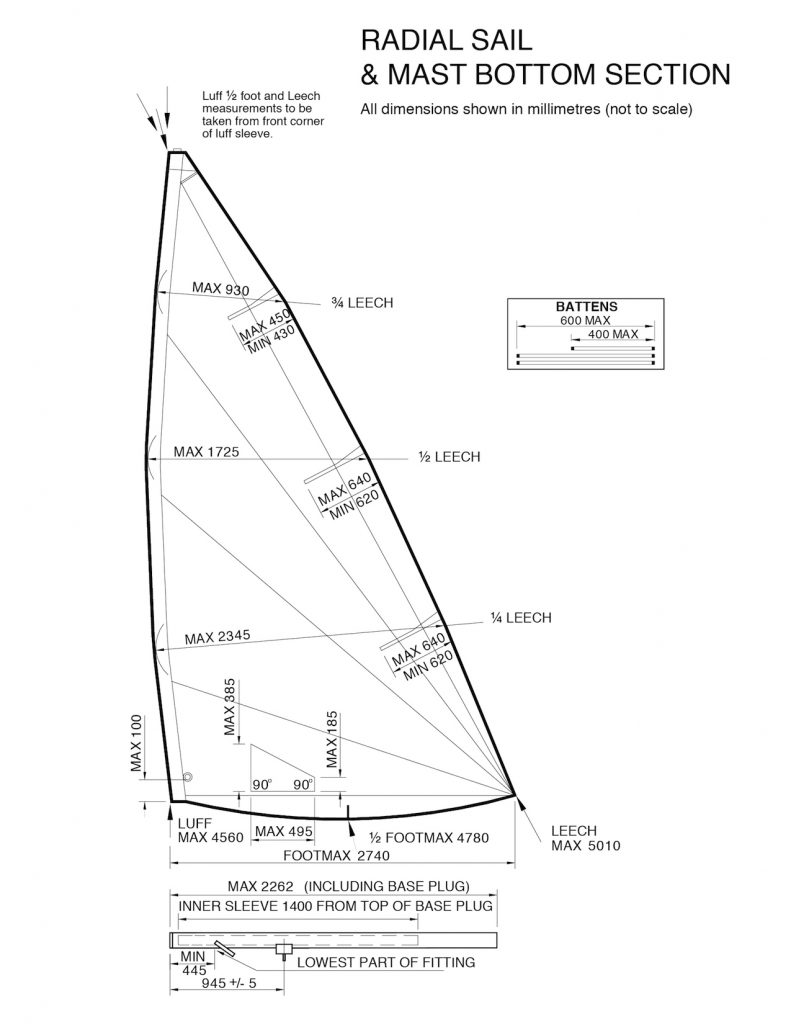
How to tell if you have a 'Radial' sail: The first and most obvious way to tell if you have a 'Standard' sail is to look at the panels. If they are radial, as in emanating out from the center, it is most likely a radial sail. Next, you can measure the luff (the front edge of the sail along the mast sleeve). This measurement should be about 4560 mm or 180 inches from the top of the sail to the bottom.
How to tell if you have a 'Radial' lower mast section: The 'Radial' lower mast section should measure about 2262 mm or 89 inches . It is also a bit smaller in diameter than the standard section.
Laser 4.7 / ILCA 5
The Laser 4.7 (or ILCA 5) is the smallest of the three Laser sails and was designed for young sailors just getting into Laser sailing. The 4.7 lower mast section is also different from the others in that is has a pre-bend near the boom fitting, allowing the sail to depower much easier. This is the least common Laser sail size, and if you have an old one around, chances are it is not a 4.7 sail.

How to tell if you have a '4.7' sail: The 4.7 is similar to the old 'Standard' sail as it has cross cut panels. Many 4.7 sails also have an obvious 4.7 logo somewhere on the cloth. Next, you can measure the luff (the front edge of the sail along the mast sleeve). This measurement should be about 4080 mm or 160 inches from the top of the sail to the bottom.
How to tell if you have a '4.7' lower mast section: The '4.7 lower mast section has a pre-bend in it and should measure about 1810 mm or 71 inches . The bend is the easiest way to tell it apart from the others.
What is the difference between 'Race' and 'Rec' rigging?
Up until about 20 years ago, the Laser featured very basic boom vang, outhaul, and cunningham controls. These were basically just long lengths of line with a series of loops and knots designed to create 'purchase' or pulling power to help tighten the controls and further shape the sail. In many ways, these rudimentary controls limited the type of sailor who really excelled in terms of performance, as you needed to be very strong and athletic to control the boat (you still do at the very top of the racing scene, particularly if you hope to compete in the Olympics). If you have a 30+ year old boat that hasn't been updated, chances are it is a 'rec' rigged boat. There is no problem sailing a Laser like this and many sailors enjoy the simplicity of the rigging and low cost of replacing line and parts.
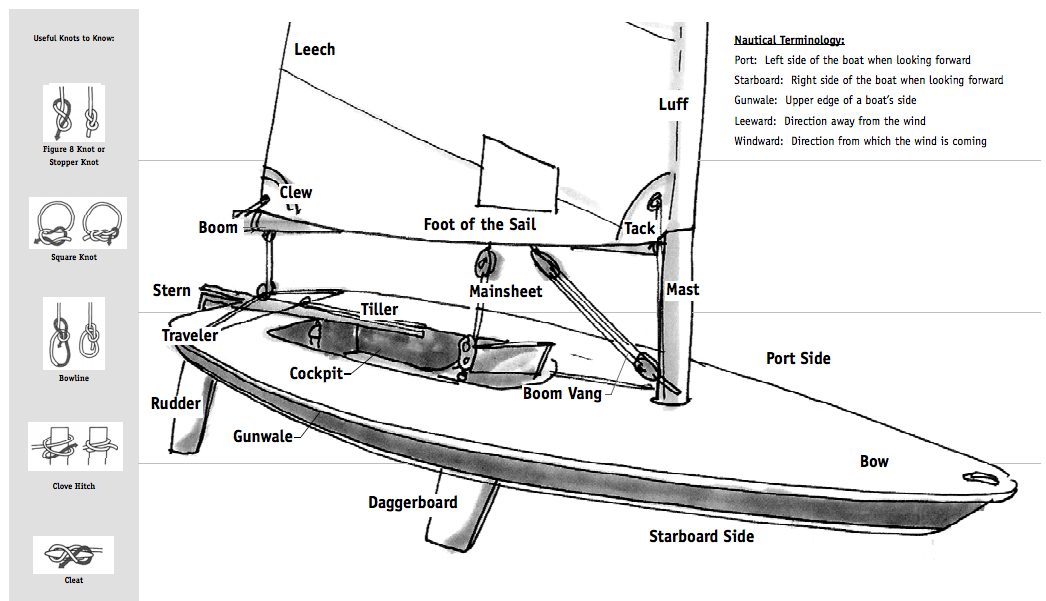
In 2000/2001, a new set of controls was approved, designed to make it easier to manipulate the sail (particularly for lighter sailors) and to rig/unrig the boat. These included a 15:1 boom vang, 8:1 cunningham, and 6:1 outhaul system. What was introduced at this time was and is still referred to as the 'Race' or 'Pro' set up, as opposed to the 'Recreational' or 'Standard' set up found before 2000. Between 2000 and 2010, many active Laser sailors upgraded their existing boats to this new standard with a series of kits (these are still available) and new boats started to include them. Starting in 2008/2009, basically every new Laser sailboat included some version of this upgraded Race rig set up. Lets take a look at how to quickly tell if your current boat is set up as a 'Race' or 'Rec' boat and then some of the differences between the two set ups.
Deck Hardware: Differences Between Race & Rec
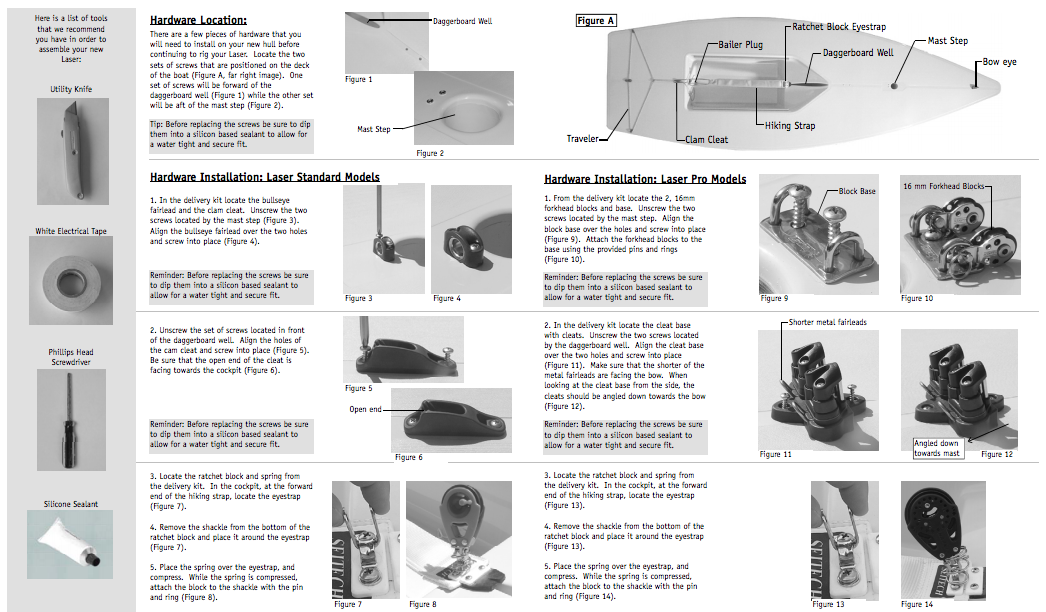
The most common question we get is how do I tell if my boat is set up with Race or Rec equipment? The quickest way to find out is to look at the hardware mounted on the deck of your Laser. Refer to the image above.
The 'Rec' setup (or 'Standard') is shown on the left , and the 'Race' set up (or 'Pro') is shown on the right. The Rec set up features a single bullseye fairlead just aft of the mast step and a single clam cleat just forward of the daggerboard trunk. These two pieces of hardware are for the cunningham control line.
The 'Race' setup (or 'Pro') is shown on the right , and features more advanced hardware. This hardware includes a deck plate with blocks just aft of the mast step (replaces the single fairlead) and a dual deck cleat in place of the single clam cleat. This new system allows both the cunningham and outhaul line to be lead down the mast and back to the cockpit for easy cleat/uncleat and adjustment from the new deck cleat system.
Insider Tip: Upgrade to 'Race' Rigging with just two kits! Back in 2000, Laser builders knew that sailors with existing boats would want a way to quickly upgrade from the 'Rec'/'Standard' rigging to the upgraded 'Race' rigging. For this reason, we still offer two kits just for this purpose.
- Laser Outhaul / Cunningham Upgrade - This kit includes everything from the blocks, cleats, hardware, line, blocks and instructions to fully update an older Laser to the latest outhaul and cunningham controls. This is the easiest way to upgrade your boat, though you will need a few basic tools to remove the old hardware from the deck and install the new components. In terms of an upgrade, this is one of THE BEST you can do to make your Laser easier to sail and to control in strong breeze.
- Laser Vang Upgrade - Upgrade to the latest 15:1 vang, no tools required! This vang system connects the same way as your old one (with a pin at the tang on the mast and with a 'key' to the fitting on the boom) and can be ready to go in minutes.
Deck Hardware: Shared Components Between Race & Rec
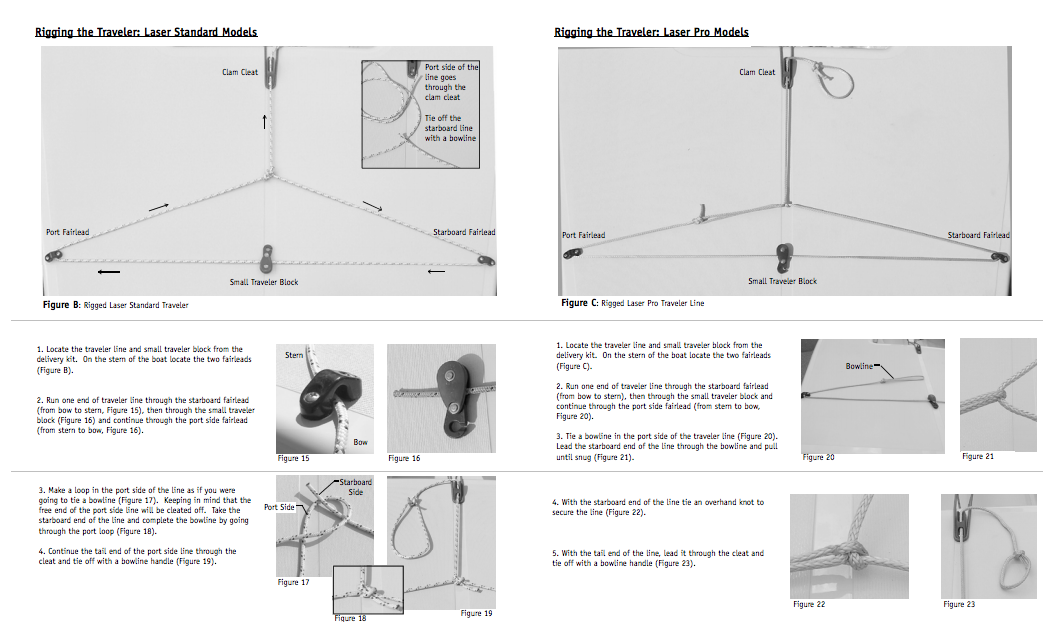
The rest of the hardware on a Laser deck is the same, regardless of what rigging specification you use. The image above shows the traveler set up, which consists of two fairleads mounted on the back corners of the boat and a single cleat mounted just aft of the cockpit on the deck. There are a few components to this area we'll mention here for your reference:
- Fairleads - Depending on the year of your Laser, you'll need either a 23mm Fairlead (found on most older boats ) or a 26mm Fairlead . We also have replica versions of both the 23mm and 26mm fairleads.
- Cleat - A single aluminum clam cleat is used for cleating the traveler. We recommend the CL221 Cleat .
- Traveler - We recommend 11 feet of a low stretch line. You can also purchase our premium Vectran Traveler with has a nicely spliced eye on one end.
Mainsheet System & Blocks
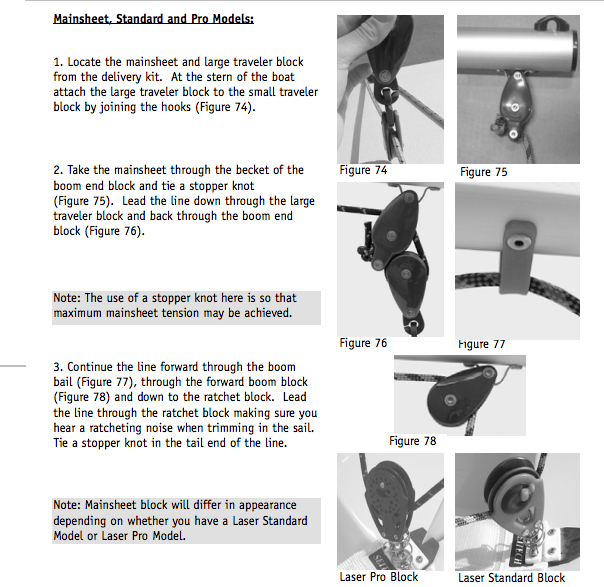
Regardless of specific rig set up, the Laser mainsheet is rigged the exact same way. The mainsheet system includes a ratchet block attached to the deck just forward of the cockpit, two blocks mounted on the boom, and a set of traveler blocks at the rear on the deck. There are a few different components and some upgrades we'll reference here.
- Mainsheet Ratchet Block - You can use any ratchet block here that is designed for a 6-8 mm line (the desired range of diameter for a Laser mainsheet). We recommend:
- Harken 57mm Ratchet Block
- Ronstan 55mm Orbit Block
- Mainsheet Spring
- Eyestrap (Stainless)
Boom Vang: 15:1 Race Vang vs 3:1 Rec Vang

The Laser boom vang is a series of blocks and line that connect to the boom with a key style fitting for quick removal and to a tang fitting with a pin at the base of the mast just above the deck line.
- Rec Vang (3:1) - Sometimes called the classic vang, this is a simple '3:1' purchase vang system with two blocks and a length of line. Here are the components.
- Classic Vang Block Upper
- Classic Vang Block Lower
- Classic Vang Assembly
- Classic Vang Line
- Race Vang (15:1) - Sometimes called the pro vang, this is a more powerful '15:1' purchase vang system with more turning points. It uses both a covered control line and pure dyneema/spectra line for strength. This is available as a full upgrade kit in a few different versions for easy install to your Laser. It is easier to install than the Outhaul/Cunningham kit as there are is no deck hardware to install - simply clip in the same way as your old vang.
- Harken Laser Vang Upgrade
- Vang Becket Block - Used at the top of the Harken Vang assembly
- Practice Vang Upgrade (Generic)
- Shared Components - There are a few pieces of hardware used on the boat regardless of what vang you have.
- Laser Vang Tang - Attached to lower mast section for connecting lower part of vang to mast
- Laser Vang Strap - Attached to boom for connecting top part of vang to mast with the key fitting via the slot
Outhaul Control System

The outhaul controls the back corner, or the clew, of the sail. The 'rec' / classic rigging is quite simple, whereas the 'race' rigging adds more power to the sail control, making it easier to adjust and flatten the sail to depower in heavy wind.
- Rec Outhaul - Uses a 10 foot length of line and the clam cleat on the boom to achieve a basic purchase system for tightening the sail. The entire control exists right on the boom.
- Race Outhaul - The upgraded race outhaul system has a few variants, but adds twice as many turning points for a more power purchase system. It uses two sections of line, a primary dyneema or spectra line in the rear and a secondary covered line in the front, which is lead down to the deck cleat for easy adjustment.
- Harken Outhaul/Cunningham Kit - Includes everything, down to the deck hardware, for adding the upgraded Outhual and Cunningham set up to your existing Laser.
- Practice Outhaul/Cunningham Kit - A less expensive alternative to the Harken kit from Allen.
Cunningham (Downhaul) Control System
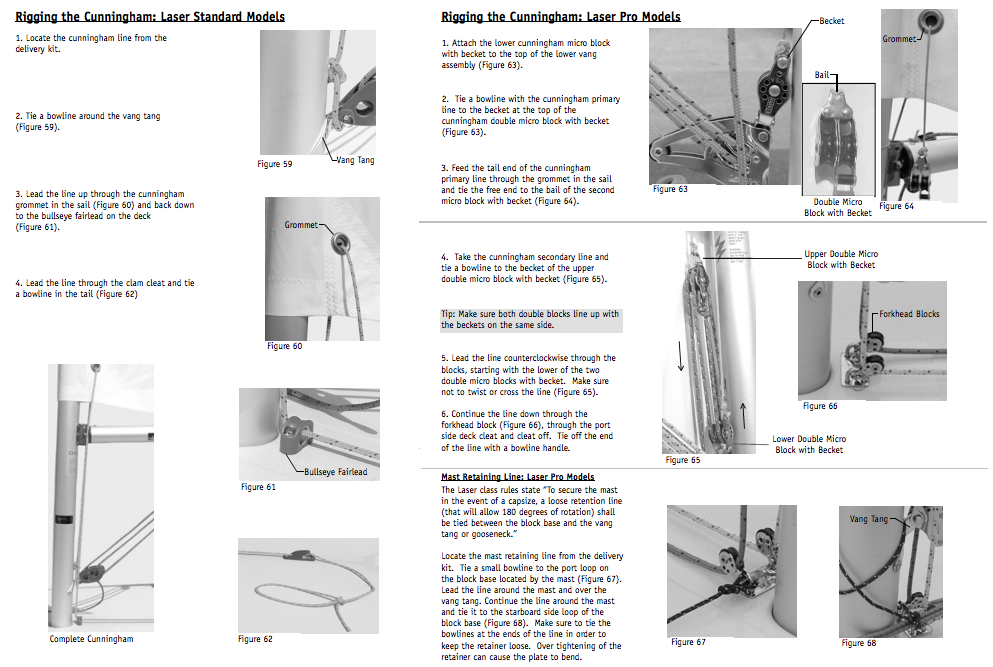
The cunningham, sometimes called the downhaul, controls the front edge of the sail The 'rec' / classic rigging is quite simple, whereas the 'race' rigging adds more power to the sail control, making it easier to adjust and flatten the sail to depower in heavy wind.
- Rec Outhaul - Uses a 10 foot length of line and the single clam cleat on the deck. The line is tied around the vang tang, up through the tack grommet, down to the fairlead, and back to the clam cleat for adjustment.
- Race Outhaul - The upgraded race cunningham system also has a few variants, but creates a powerful 8:1 purchase system. It uses two sections of line, a primary dyneema or spectra line to pass through the tack grommet and a coverer secondary line which is fed through the blocks and lead down to the deck cleat for easy adjustment.
- Harken Outhaul/Cunningham Kit - Includes everything, down to the deck hardware, for adding the upgraded Outhual and Cunningham set up to your existing Laser.
- Practice Outhaul/Cunningham Kit - A less expensive alternative to the Harken kit from Allen.
Subscribe To Our Newsletter
Sign up for our newsletter to receive exclusive discounts, new product announcements, and upcoming sales.

Guide to Laser Pico’s and Dinghy Sailboats
- Home / Category / Active
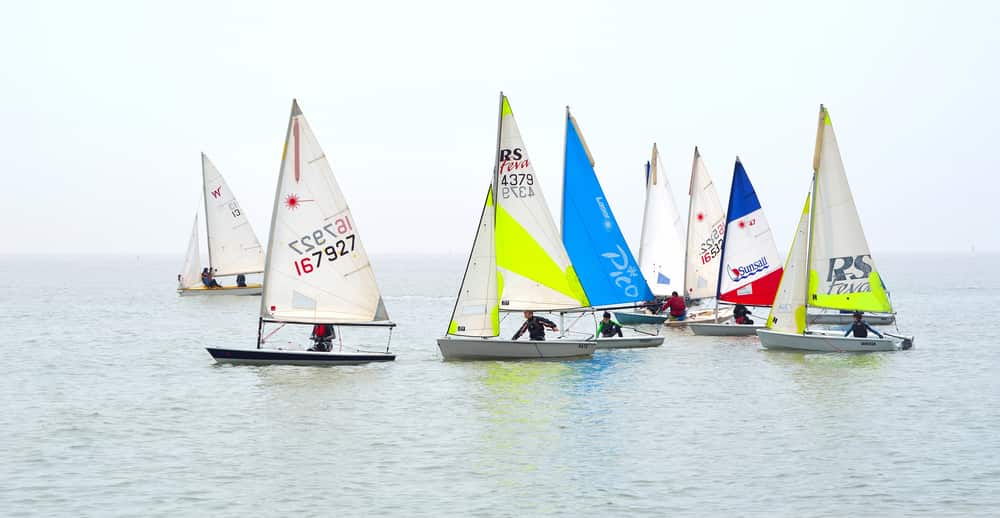
- March 25, 2022
- Author: Robert Puharich
The laser boats were first produced at the beginning of the 1970s and attained the Olympic sailing category in 1996. Since then, these boats have become the most competitive sailing boats designed in history.
For this reason, all laser boats are constructed with similar specifications, including their sails, equipment, and hulls. The laser Pico and Dinghy Sailboats are among the common types of laser boats you can use to test your skill as a sailor and advance in this hobby.
Most starters may ask, how do these boats operate? How many people can they hold? Are they expensive? And what’s the difference between the two? If these are your concerns, you’re at the correct place.
This article provides everything there is to know about laser Pico’s and dinghy laser boats to help you know which is the most suitable one for your sailing hobby.
The Laser Pico
Developed primarily for fun, the Laser Pico has constantly remained the prevalent sailboat of all times and abilities. The boat is easy to use and rig and facilitates a speedy learning curve, making it easier for a single sailor to utilize it comfortably.
The boat was first designed by an Olympic medallist known as Jo Richards and was built in 1998 by LaserPerformance . Current Pico models use the latest manufacturing process to ensure it offers nothing but the best experience while on water.
The Laser Pico is the best option for both novice and savvy sailors. The boat alienates the pressure of newcomers having to spend hours learning how to use it. The modern Pico is very simple to rig and sail that a beginner can master how it works in a day.
It’s rare to find a boat with the combination of features and qualities found in Laser Pico’s. For beginners, this laser sailboat is vice free, simple, and stable enough that almost anyone can easily use it. However, pro users will delight in its brisk performance and highly responsive nature.
Pico is true to its size and rides with a smooth motion regardless of its flat underwater outline and flared bow sections. It doesn’t require great intricacy when steering or trimming due to its well-built rig and enormous rudder.
The boat has positive and well-balanced steering that offers precise feedback for the sailor, and is made to quickly notice forces that are out of balance. Its hiking straps are suitable even for bare feet, while the curved decks work well for people with different leg lengths.
The Laser Dinghy
A dinghy refers to a small open boat often towed or carried on larger ships and used as a tender or lifesaving boat. Other dinghies are usually designed for sailing, and the best example is the Laser Dinghy sailboat.
The Laser Dinghy, also known as the Laser Standard or the Laser One, was first designed in 1970 by Bruce Kirby, with more emphasis on performance and simplicity. The boat is in the international class and used by sailors in more than 120 countries.
Its popularity and wide acceptance come from its simplicity to rig, sailing ease, and robust construction. Its numerous features and great association controls make it a competitive sailing boat.
Usually, most people use the word ”Laser” to describe the Laser Standard, the largest plan rigs you can find for the Laser hulls.
But there are other types of Laser Standard sail plan rigs and many Laser-branded boats with entirely dissimilar hull designs, such as the Laser Pico and Laser 2. The Laser Class Association only offers three kinds of Laser boats: the Laser Standard, Laser 4.7, and Laser Radial.
All Laser boats are constructed with similar specifications and are usually light enough to be carried on top of car racks. However, they are suitable for people of different sizes and ages.
For instance, the Laser Standard is best for fit, muscular, and agile sailors weighing over 80kgs. On the other hand, Laser 4.7 and Laser Radial sailboats are good for small sailors with less weight.
Features to Look for When Purchasing a Sailboat
With many manufacturers producing dinghies today, you’d want to ensure the one you purchase is the best the market offers. For a starter, it’s easy to buy a second-rate or poorly constructed sailing boat if you aren’t careful.
Some of the essential features to check are:
1. Sailboat Number
Most dinghies have sailboat numbers on their cockpit’s back or the deck. These numbers usually help to identify the age and quality of the sailboats. The newer ones tend to have the numbers etched on their cockpit’s backs, while the older dinghies have these numbers written on their decks.
2. The Deck and Hull Condition
It’s important to ensure that the deck and hull of the sailboat you purchase are in good condition. It would be better to watch out for any deep scratches and cracks as they’re the primary tell-tale indications of leaking and damages on the boat.
Usually, this number includes three letters followed by a series of numbers and letters. The first three letters are normally the production date, while the remaining five are the sail serial number.
3. Stiffness
Stiffness is used in boats to indicate their ability to withstand heeling forces. A stiff is boat is usually more stable and responds rapidly to wave profile. However, the stiffness usually diminishes with use and time; hence could tell you the sailboat’s overall quality. Softer ones are more likely to leak.
4. Mast Step
The mast step takes the highest pressure from the sail and mast. A mast’s primary purpose is carrying the soars, derricks, sails, and offering the required height for a lookout position, signal lamp, navigation light, and radio aerial. Therefore, it’s important that the mast step of the boat you buy is in good condition.
5. Other Parts of the Boat
Besides the parts mentioned above, it’s always best to make sure other parts of the laser sailboat you buy are in excellent condition. Examples of these parts are the rudder, daggerboard, mast and boom, and tiller and tiller extension. You should check them for straightness and inspect the ropes and sails for wear and tear.
Why Pico Sailing Is an Extremely Fun Hobby
Laser Pico is the most exciting and capable boat you can ever sail with. It features a:
- Robust dacron sail
- Simple reefing system
- A reefing mainsail and removable jib
- Stable and stiff roto-molded hull, and more
- Four-padded toe straps
These features, plus the boats superb design, high durability, and stiffness, make it a great choice for beginners and experienced sailors. Anyone can rig and sail it easily, and most first-time users are normally in charge of them after several days of use.
It’s surprisingly fast and accelerates briskly on the water with a good amount of breeze. Pico’s daggerboard fits easily and can clear the kicking strap and boom even when raised fully, allowing simple lee shore launching and preventing any foul-ups when gybing .
The Laser rudder system utilizes the famous swing-down-and-lock-with-the-tiller arrangement, fastened with a bungee cord you can replace easily. Its hull is produced using the latest process for higher stiffness and durability to ensure safety and longevity.
Therefore, you can expect to have a lot of fun and memorable sailing moments with your Laser Pico for years to come. Its high-capacity allowance and cockpit size are sufficient enough for you and your youngster to go sailing together and teach them more about this fun hobby.
Although the hull of this boat is slightly heavier, its durability and numerous essential features still make it a world-class sailboat. It’s fun, exciting, simple to use, modestly priced, and simple to maintain.
What’s The Best Beginner Laser Sailboat?
The laser boats come in different sizes and types. However, these boats have similar specifications since they’re built to be competitive sailboats to gauge sailors’ skills. Several factors determine the best Laser boat for you, including your age, weight, and experience level.
The Laser sailboats come in three main types; the Laser Standard, 4.7, and Radial. There are also two other types not formally recognized as the Laser class. The main types are designed for sailors with different weight capacities. Below is more comprehensive detail about them:
1. Laser Standard
This Laser bought is the one discussed above, also called the Laser Dinghy. It’s built for sailors weighing 70-84kgs.
2. Laser Radial
Laser radial is slightly smaller than Laser Standard. It’s the one utilized during the 2008’s Women singlehanded Dinghy Olympics and is suitable for people weighing 55-72kgs.
3. Laser 4.7
Laser 4.7 is smaller than the Laser Dinghy, and its shape differs from Laser Radial. It’s built for sailors with a weight of 50-55 kgs.
Two Other Types of Laser Sailboats Include:
Laser M is the rare Laser sailboat model with a smaller hull designed for smaller sailors. Its mast is short, making it a bit challenging to use and depower, particularly with stronger winds.
2. Rooster 8.1
This type of Laser is produced in the UK, and it features a larger hull meant for larger sailors. It’s constructed with varying mast length options.
The first three rigs differ in size, with the Standard measuring 76 sqft, the Radial being 62 sqft, and the 4.7 is 51 sqft. All these boats are suitable for different people. Usually, the Laser Standard is good for advanced sailors, the Radial is ideal for intermediate sailors, and the 4.7 is best for young sailors getting started with the hobby.
What’s The Weight of a Laser Sailboat?
The optimal weight for laser boats differs with each type. Generally, a standard Laser boat should weigh between 55-72kg.
Laser Vs. Laser 2- What’s The Difference?
The main difference between a Laser and Laser 2 is that the latter has a double-handed design while the first one is single-handed. Also, the laser 2 should be sailed with a jib, or else there will be excess weather helm, and it may fail to move.
The Laser 2 is also bigger than the standard Laser, and it can run a jib, main, and spinnaker. Its cockpit is larger and can accommodate even two adults; however, sailing it alone is tricky.
Winding-Up Laser Pico’s and Dinghy Sailboats
The laser boats are excellent options for anyone wanting to hone or learn their sailing skills and enjoy the hobby more. They’re highly responsive, well-built, simple to use, move briskly, the right size, and fun to sail in moderate and light winds, even for beginners.
However, you need to select the right type to be safe and have the utmost fun. Usually, you need to consider your age, weight, and skill set before purchasing one. Have fun sailing!
Search this website
Latest articles.

Is Basketball a Hobby?
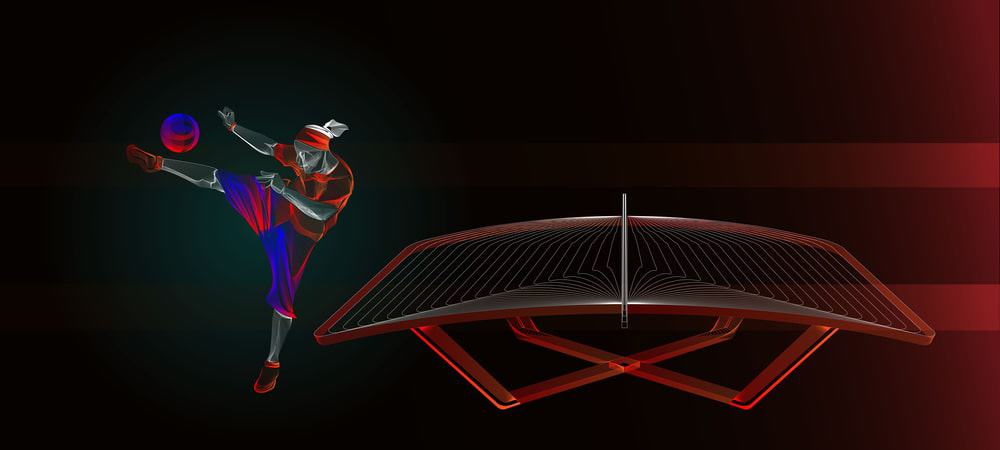
What is Teqball? Your Guide to a New Sport

29 Problem Solving Hobbies to Keep Your Mind Busy

How to Play Tchoukball | A Beginners Guide

Is Working Out a Hobby? Find Out Here

25 Best Hobbies for Men Over 60

Exotic Pole Dancing: A Creative, Athletic Hobby

Is Listening to Music a Hobby? Consider this…

25 One Handed Hobbies to Try
Share this article: , keep up with new hobbies.
- Sailing Jackets
- Sailing Trousers
- Sailing Shorts
- Fleeces & Midlayers
- Sweatshirts & Tops
- T-Shirts & Polos
- Spraytops & Smocks
- Dinghy Boots
- Buoyancy Aids
- Dinghy Gloves
- Dinghy Headwear
- Sailing Boots
- Deck Runners
- Footwear Care
- Changing Robes
- Swimming Gloves
- Swimming Socks
- Swimming Goggles
- Safety Buoys
- Changing Mats
- Victorinox Swiss Army
- Clothing Care
- Flasks & Sports Bottles
- Sea Sickness Aids
- Paddleboarding
- Water Toys & Towables
- Clocks & Barometers
- Model Boats
- Brass Bells
- Clothing Gifts
- Miscellaneous
- Clothing Specials
- Clothing Clearance
- Lifejackets
- Lifejackets Accessories & Re Arm Kits
- EPIRBs & PLBs
- Lifebuoys & Liferafts
- Safety Accessories
- Winch Handles
- Tillers & Extensions
- Cleats & Clutches
- Wind Indicators
- Topper Hardware
- Topaz Boats Hardware
- ILCA / Laser Hardware
- Optimist Hardware
- All Dinghies
- Epoxy & Fillers
- Cleaning Products
- Bilge Pumps
- Dehumidifiers
- Stain Removers
- Water Treatment
- Shackles & Stainless Steel Fittings
- Navigation Lights
- Deck Equipment
- Inspection Hatches
- Pilots & Sailing Directions
- Charts & Navigation
- Instructional Reading
- Knots & Rope Work
- Technical Books
- Dinghy Books
- Bunkside Reading
- Kids Reading
- Topside Paint
- Paint Accessories
- Race Compasses
- Anemometers
- Shore Power
- Torches & Head Torches
- NKE Marine Electronics
- Gift Vouchers
- Sailing Dinghies
- Outboard Engines
- Electric Outboards
- Inflatable Dinghies
- Lubricants & Engine Oil
- Fuel Treatment
- Outboard Accessories
- Gift Voucher
- End of Season Boat Sale

- Fleeces & Midlayers
- Sweatshirts & Tops
- T-Shirts & Polos
- Spraytops & Smocks
- Flasks & Sports Bottles
- Water Toys & Towables
- Clocks & Barometers
- Lifejackets Accessories & Re Arm Kits
- EPIRBs & PLBs
- Lifebuoys & Liferafts
- Tillers & Extensions
- Cleats & Clutches
- Epoxy & Fillers
- Shackles & Stainless Steel Fittings
- Pilots & Sailing Directions
- Charts & Navigation
- Knots & Rope Work
- Torches & Head Torches
Which Laser sail is best for me, and what are they made from?

What is a Laser Dinghy?
A laser is a single - handed ILCA dinghy which is 4.2m in length and weighs 56.7kgs. It is one of the most popular single - handed dinghies in the world due to its simplicity and affordability. This class is protected by the strict one-design class rules which ensures no changes are allowed to be made to the boat unless they are specifically mentioned in the class rules. The laser is an Olympic class boat which first made an appearance in Atlanta in 1996. The class ensures the one - design rules allow sailors to excel based on their ability to sail the boat, not the condition of the sails etc. This one design rule means that if a laser hull is maintained the resale value of a laser remains very high.
The laser has a standard hull design with three different types of sails. This allows sailors to progress depending on their ability and weight and height, making it a boat that can be sailed for many many years by all ages. These rigs are known as ILCA 4, ILCA 6, ILCA 7 or otherwise more commonly known as 4.7, radial and standard rig.
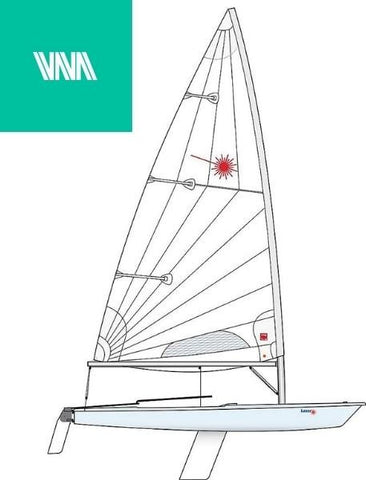
Which Laser rig is best suited for me?
The laser has a two part mast, allowing for interchangeable bottom sections as well as a sleeved sail which allows for easy rigging. This is unlike other dinghies which require extensive preparation in relation to rig set up.
The Laser 4.7 (ILCA 4) sail uses a short pre-bent lower section which in turn reduces the sail area by 35% compared to the standard rig. This creates a more balanced helm which compensates for the fact the sailor is lighter than a standard rig helm. This allows helms to learn the basics of sailing as a beginner and also provides sailors with a boat to transition into after smaller dinghies such as an optimist. This rig is ideal for lighter weighted sailors 35-55kg. This is also an ideal rig for a beginner who struggles to control a Laser Radial rig.
The Laser radial (ILCA 6) sail uses a more flexible, slightly shorter lower section compared to the standard rig. The sail area is 18% smaller than the standard making it easy to manoeuvre. The laser radial is by far the most common sail configuration which is used worldwide by over 200,000 sailors across 140 countries making it the most popular youth and single handed dinghy. This rig is used by the Olympic federation as the rig choice for women competing. It is the perfect rig for a 55-70kg sailor.
The Laser standard (ILCA 7) sail and rigging or otherwise known as a ‘full rig’ is ideally set up for heavier weighted people due to the increased sail area. This rig is the preferred choice for men competing in the Olympics. This sail requires a Standard bottom section which differs from the radial bottom section. This rig is suitable for sailors above 60kgs.
How can I tell the difference between the sails by looking at them?
These rigs are clearly identifiable looking at the Laser. The Laser 4.7 has a smaller sail area which is visible at the end of the boom as it is shorter than the other sails. The Laser radial has a blue patch at the clue and tack of the sail. This sail goes to the end of the boom unlike the 4.7 rig. Similarly, the standard rig extends to the end of the boom however, it does not have the blue patches on the sail like the radial.
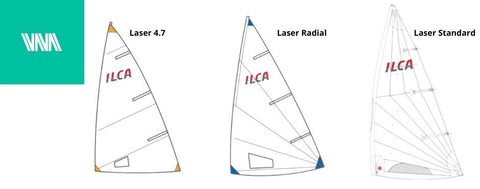
What is the new Laser Standard Sail design like?
In 2018, a new standard sail was ILCA approved which is referred to as ‘Mark II’ or ‘Mark 2’. There is no difference in size between the Mark I and Mark II however, the Mark 1 has horizontal cut panels compared to the Mark II which has radial cut panels. The Mark II sails also require Mark II battens rather then the Mark I battens . The Laser Class Association was determined to ensure the integrity and quality of the Mark I was not overshadowed by the new Mark II. They did this by creating the Mark II which focuses solely on durability. Therefore, the main difference between the two sails is durability. Clive Humphris, the ILCA Technical Officer is quoted in the class magazine as saying "The main objective of the design project for the Mark II was to create a sail with equal performance to the existing sail, but with better durability. We worked very hard to ensure that the Mark II was not a faster sail and wouldn't make all the existing sails obsolete overnight. The original Laser standard sail will continue to be available through authorized Laser dealers and we fully expect to see the two designs racing side-by-side for a number of years."
The new Mark II sail is made from a heavier cloth from 3.8 to 4.5 dacron material. There has been a change in the reinforcement patches which increases durability and maintains a better sail shape when under pressure. The window is noticeably bigger, as well as improved tapered battens with velcro batten pockets. The mast sleeve has been improved which reduces the amount of creases along the sail. The Laser Class Association successfully created a newer model sail for the Laser Radial without hampering the one design class which focuses on the condition of the boat, not the additional moving parts that can cause a substantial benefit to your racing.
What sail is best suited for me?
There are three types of Laser sails, Official Class Legal Sails, Class Compliant Sails and Training Sails.
Official Class Legal Sails - These sails are class compliant and are required for International and National events. There is a red button on these sails demonstrating that the supplier LaserPerformance has paid a contribution to the Laser class association. This allows them to be considered ILCA approved. These sails have 6 sail numbers on both sides with the first two numbers being red and the latter 4 coloured black.
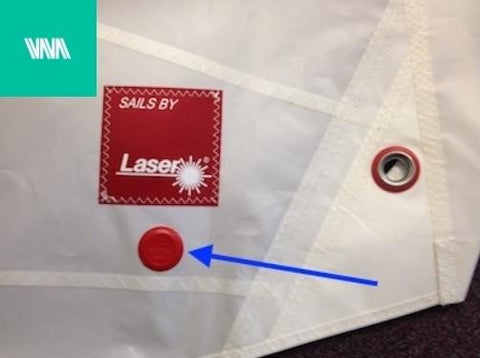
Class Compliant Sails - These sails are ideal for training camps or non class events. They are a higher standard than a training sail which provides a good basis for training and events with lesser importance. This sail has 6 sail numbers on both sides with the first two numbers being red and the latter 4 coloured black.
Training sails - These sails are made from a thinner material which reflect the cheaper price. They are ideal for sailors that are starting out and need a sail to compete in club races and training. This sail has 6 sail numbers on both sides with the first two numbers being red and the latter 4 coloured black.
Leave a comment
Please note, comments must be approved before they are published
International Laser Class Association
One Boat, One Sailor, One Design.

Introduction to Laser Sailing
by Jon Emmett
The Laser is truly the boat for all ages from our Junior 4.7s to our legendary (over 75 year old) Masters. No other adult class is raced in more countries in the World, in a class which takes grass roots to Olympic sailors. Come and join us to see why!
Not only are there nearly 215, 000 boats out there at the time of writing, but there is truly something for everyone in a combined class which covers the competitive weight range for nearly everyone from junior to adult, although it is not just about racing. Lasers form a key part of many sailing holiday fleets for people who just want to blast or potter around for fun.
Many of the world’s best sailors, difficult to mention them all, have come through the Laser rank. It seems like medalling in an international Laser event means you are likely to be able to medal in future classes as Laser sailors go on to compete in nearly every aspect of the sport. Ben Ainslie, Iain Percy, Paul Goodison, Robert Scheidt, Francesco Bruni, Tom Slingsby are probably the best known, and with so many to choose from it is hard to know where to start. Behind them, there is a whole host of talent with the level just getting higher and higher.
Photo by Jon Emmett
The inspiration for a young sailor joining the fleet is there for all to see. Yet for the Masters, the competition is in a way no less fierce and keeping active in older age is recommended on so many levels. After all, Laser sailing has been compared to cycling, so it certainly keeps testing you both physically and mentally, and the Masters’ European circuit continues to go from strength to strength.
The core skills you learn in Lasers: the starting, the tactics, and the fitness lifestyle are for life, not to mention the ability to surf downwind whilst within Rule 42, and navigate every type of wave upwind in a non-planing boat. We are always learning, and this is the reason the Laser remains as popular today as when it was first launched as a beach boat in 1969.
It is not only about having a rig for every weight but competition for every level. Of course, this varies from region to region. Another beauty of the Laser is the ability to jump on a plane and charter a boat when you get to the regatta. Due to the class’s numbers, there is no other class where this option is so widely available.
So, whether your aim is simply to have fun on those warm sunny days when the wind allows you to plane freely without getting blown off the water, or you have the Olympics firmly set in sight, there are step-by-step routes to success.
Club sailing: There are very few dinghy clubs anywhere in the world without a Laser or two, meaning that fleet racing is possible. This really is the true test of skill, racing against someone in an identical boat. Whilst handicap racing has its place and means, we can race our friends who are of very different body weights or sail very different boats, this is a far from perfect system because an overpowered boat will always tend to do well in light winds and an underpowered boat do well in strong winds, especially if it has a trapeze and can plane upwind!
Europa Cups are not only for European sailors. Indeed, we see many sailors from all over the world attend these and they make an excellent stepping stone to other international events. More and more, the other regions are having their own circuits of events.
Europeans: In recent years, probably the greatest depth of competition has been found in the European region, meaning those from other regions will travel to participate not only in the EurOlym regattas (Olympic class events in Europe) with world class venues such as Garda, Medemblik, Kiel, as well as the European Championships (and Open Trophy) themselves. For example, in Asia we have the Asian Games, in America the Pan-American Games.
For more information please see http://www.eurilca.eu/
However other regions are working hard to catch up.
Some useful links: Europe http://eurilca.org/
Asia http://www.asiansailing.org/
North America www.laser.org/
Australia http://www.lasersdownunder.com/
Worlds: For some, just qualifying for the Senior Worlds is a massive task, with the level going up and up and up. However, Laser sailing really does have World Championships for everyone with Junior (4.7), Youth, Under 21, and of course the other end of the scale, Masters’ Worlds! For more information please see http://www.laserinternational.org/
Perhaps the biggest Worlds is the Sailing World Championships run by World Sailing every 4 years, which features all Olympic classes, and sitting roughly in the middle of the Olympic cycle is the major country qualifier for the Olympics.
World Cups: Being an Olympic class, both the top Laser and Radial sailors will do the invitation only World Cup Series, which also forms a very important part of the World Sailing ranking (as these World Cup events generate a lot of ranking points). The circuit currently visits Asia, North America, Europe with a final, for an even further reduced number of sailors counting all three events. For more information, please see http://www.sailing.org/ .
Jon Emmett is an Olympic Gold medal-winning coach, guiding Lijia Xu from China to Gold in the Laser Radial class at the 2012 Olympic Games in London. He also sails competitively himself in worldwide regattas when he has the time. Check out his Facebook page, Jon Emmett Sailing, where he posts his latest training videos: https://www.facebook.com/jonemmettsailing/
🚚 Fast Dispatch - Getting You Back on the Water ⛵️

- Gelcoat Fillers
- Dry Lubricants
- Adhesive Glues
- Hooks & Clips
- Catamaran Launching Trollies
- Jockey Wheels
- Hitch Locks
- Lighting Board
- Breakaway Cables
- Clew Straps
- Upper Masts
- Lower Masts
- Rope Thimbles
- Wind Indicators & Burgees
- Parrel Beads
- Whipping Twine
- Sailmakers Palm
- Digital Compasses
- Laser Products
- Numbers & Letters
- Dinghy Covers
- Under Covers
- Catamaran Covers
- Single Handed
- Double Handed
- 18 Foot Skiff
- Exocet Moth
- Musto Skiff
- Dart 15/ Sprint 15
- Hurricane 5.9
- Laser Bahia
- Laser Cascais
- Laser Funboat
- Laser Stratos
Your Cart is Empty
- £0.00 Subtotal
Tax included and shipping calculated at checkout
Order before midday Monday to Friday and we will ship your order the same day.
- 01268 222912
- Accessories
- Sails & Covers
- Rope Lengths
- Parts By Boat
- Boat Care & Cleaning
- Splicing Tools
- Boat Covers
- Dinghy Rope Lengths
- Laser Rope Lengths
- RS Rope Lenghts
- Catamaran Rope Lengths
- Laser Performance
- Topper Sailboats
- Other Boats

- Mens Sailing Clothing
- Womens Sailing Clothing
- Repair Kits
- Skiff Suits
- Life Jackets
- Trapeze Harnesses
- Buoyancy Aids
- Hiking Pads & Pants
- Hiking / Toe Straps
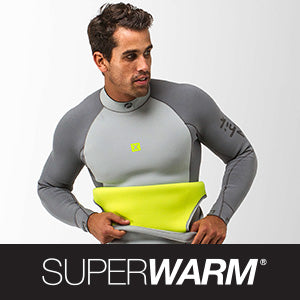
Zhik Superwarm
- 100m Rope Reel
- Polyester Ropes
- Control Lines
- Double Braids
- Braid On Braid
- Anchor Lines & Ropes
- Spools & Reels
- Windsurfing
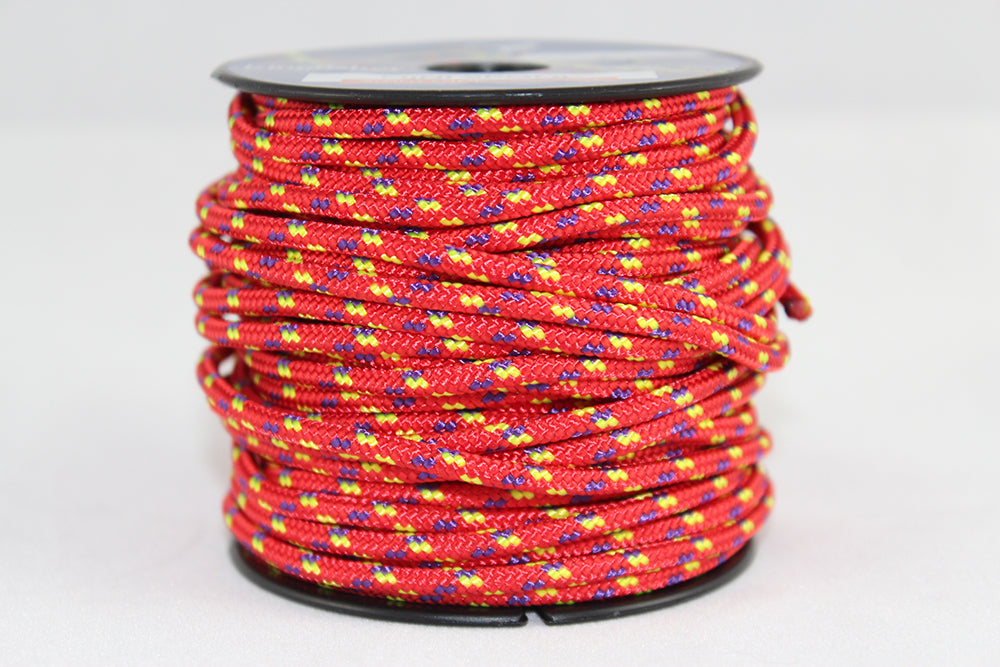
Mini Spools
- Single Block
- Double Block
- Triple Block
- Soft Attach
- Split Rings & Pins
- Inspection Hatches & Covers
- Bungs & Sockets
- Rudder & Tiller Parts
- Bushes & Fairleads
- Marine Screws
- Penny Washers
- VHF Aerials & Antennas
- Marine Tapes
- Traveller Systems And Parts
- Traveller Blocks
- Pico Hull & Deck Fittings
- Hull & Deck Fittings
- Laser Boats
- Laser Sails
- Laser Sail Packages
- Laser Spars
- Laser Rig Packages
- Laser Foils
- Laser Hull & Deck Fittings
- Laser Ropes
- Laser Dinghy Covers
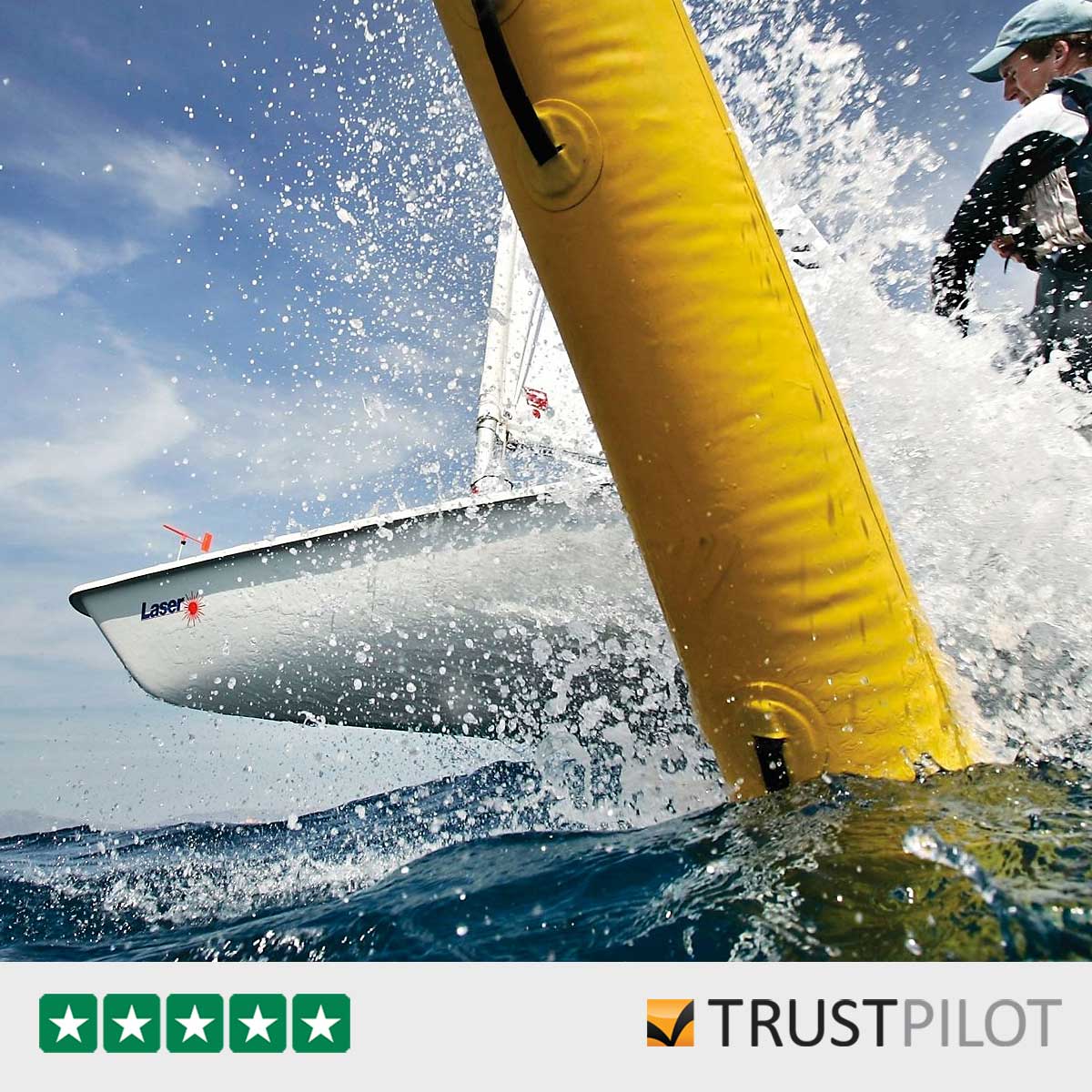
Brand New Laser Boats
- Devoti ILCA Boats
- ILCA Sail Packages
- ILCA Rig Package
- Devoti KDK Boats
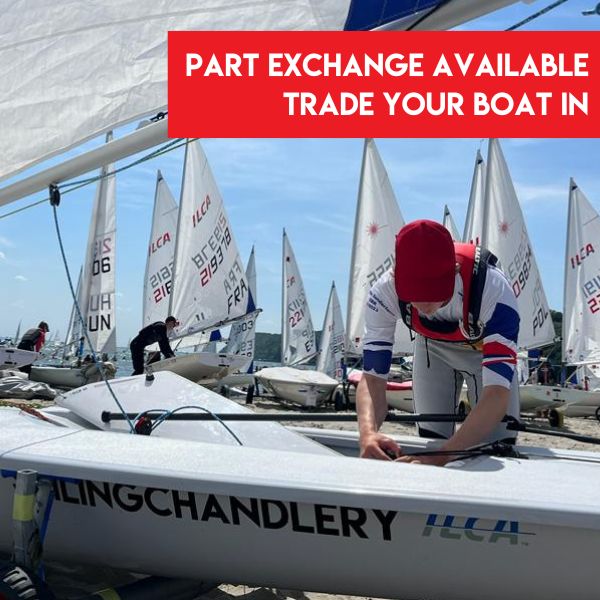
Part Exchange Your Boat
Search our chandlery
🚚 Fast Dispatch and a 5 Star Rated Service You Can Count On ✅

Laser Sailing - How to get started
August 17, 2018 4 min read
So, you're looking into Laser Sailing but maybe you're not sure how to get started with buying a Laser and keeping it sailing. Well you've come to the right place, as an authorised Laser Performance boat and parts dealer we can help.
First of all, it's important to say the Laser is a great boat, first introduced at the 1971 New York Boat Show it's gone from strength to strength with it being the choice of Olympic sailing for both men and women and with over 200,000 being built to date. In the UK there is a very active class association with events up and down the country with hundreds of boats attending the larger events.
Laser Sailing Boat Key Facts
- Year of design - 1969
- No of sailors - 1
- Draft - 0.787m
- Hull weight - 58.97kg
- LWL - 3.81m
- Beam - 1.39m
- Rig types - Standard (full rig), Radial and 4.7

Buying a Laser Sailing Dinghy
There are two options when buying a new Laser sailing dinghy.
The large majority of people starting off with a Laser will buy second hand, there are a number of places in the UK where you can source a second hand Laser, here are just some examples:
- Apollo Duck
- Dinghies and Dinghy Bits for Sale Facebook Group
- Yachts and Yachting Magazine
- Club Notice Boards - worth looking at a busy Laser Sailing club
If you are thinking of buying a new boat then you've come to the right place. Sailing Chandlery have boats readily available and can tailor a package to suit your sailing needs.
The easiest way to get started is to review the Laser boats for sale on our website along with prices and then give us a call to tailor your package.
You can call us on 07793 953564.
Which Laser rig?
The superb thing about the Laser is that it can be a boat for many different people and is especially a great boat for smaller youth sailors who will grow over time and can simply swap in and out the three different rig options.
The rigs available are:
- Laser Standard - traditionally for men
- Laser Radial - traditionally for lady and youth sailors
- Laser 4.7 - traditionally for youth sailors

Although the above is what has typically happened in the past we've seen plenty of female and youth sailors sailing a Laser standard, it's simply down to personal preference. You could have a full (standard) rig for light winds and then a radial for the windier days.
You'll save a bit of money on a Laser 4.7 sailing boat because the sail is slightly cheaper. The radial and standard sails are the same price so the boat package prices do not differ.
What's included with a new Laser boat?
Many Laser dealers (Laser Performance included) will give you a price that looks attractive until you realise that a launching trolley and boat cover isn't included. For us these are essentials for when you're buying a new boat so we've created packages which include these essential items.
If you were to buy a package from Sailing Chandlery you would receive the following:
- Spars to include mast sections (depending on rig chosen) and boom
- Carbon composite top mast section
- Tiller and tiller extension
- Class Legal Sail (depending on rig chosen)
- All blocks and pulleys needed
- Launching trolley
- PVC boat cover (polycotton breathable covers are also available as an extra)
This is essentially everything you need to get sailing and to start to enjoy your brand new Laser.
Additional options such as different sized rigs, road trailer, under cover and much more are also available - let us tailor a custom package for you, you won't be disappointed.
Spare Parts
Have you bought an older boat and need to get it refreshed?
As one of only a few official Laser Performance dealers in the UK we are able to help and carry a large range of Laser parts and spares in stock ready for dispatch.
In our experience, the most popular upgrades for a Laser purchased second hand are:
- XD kit upgrade - many older Lasers still have the traditional control line systems
- New sail - there are three different types of sail - Training, Class Compliant and Class Legal - you might not need to spend the money on an official class legal sail
- Different rig - we provide rig packages so you can get everything you need as one tailored product
- Zhik Laser Toe Strap
Time to Learn
This is all about time on the water, get out there, start sailing and enjoy the Laser sailing dinghy.
If you want the best reading on the Laser we would recommend The Laser Book.
Got questions? We're always happy to help, whatever the question please contact us and ask away.
Recent Articles
- Pre season Check List
- Where Should My ILCA Tell Tales Go
- What Are The Basic Tools Needed To Start Rope Splicing?
- You Don't Always Need Dyneema
- Boat Care and Cleaning Products
- Ropes for Club Boats and Club Dinghies - The Bosuns Guide
- Why You Should Use Two Sailing Watches
- Setting Your ILCA Dinghy Controls Up For Success
- 7 Items To Make Your Boat Go Faster in 2023
- Rope Termination to Retain The Most strength
Let customers speak for us
Just brilliant, exactly what I needed and good quality. Fits perfectly. Fast delivery and usual great service. Thank you, highly recommended
I use this tape to repair waterproof jackets and it is as strong and waterproof as many other alternatives and much cheaper :)
This cover fits easily over the boat with masts and boom placed on a set of spar holders. There is a neat velco opening to bring out a bowline to secure to the trolley.
A new innovation surprise is having clips on both sides of the cover. You can unclip from whichever side you are on.
Sailing Chandlery have listened to feedback from a previous purchase of the older design. Remains to be seen how it weathers, how breathable and water-proof it all is, but looking v smart from new.
Probably the most comfortable visor I’ve worn. I put it to the test in Dubai last week, it never budged, and wasn’t too tight or hot. The little clip gives added reassurance that you won’t loose it. I’m very pleased with the purchase.
There’s a reason I keep on buying these. My last pair lasted 4 years of use, sailing almost every weekend. They last and when you consider the cost and use, it probably works out to be the equivalent of buying a really cheap pair once every 6-12 months. Why buy twice? Very comfortable and supportive.
What more can be said, easy to fit and do the job
Very happy with the Kingfisher braid on braid, very easy to splice.
Great top, fits perfectly. I’m purchased a size 10 and is true to size.
I am very happy with my products . The advice on the kicking strap replacement rope was very helpful. Love thee we colour and material of the Velcro strap. Thank you 🙏
Needed floating cleats to secure a freestanding mast middle of RIB. Ideal adjustable guy system created using these.
As expected at a good price with fast delivery
This is a top quality rope, a bit stiffer on hands than polyester braind on braid but much lighter for the same breaking load, I bought it for sheets on a light air sail. It is perfect for the job.
Massive thanks to Andrew and team. The boat was immaculate, stiff hull and package of new kit. Asked whether we could collect the boat between Christmas and New Year en-route to an event and the Sailing Chandlery team couldn’t have done more to help. Thank you.
Thanks they look great but I haven’t put them on yet!
Part delivered on time
SIGN UP TO OUR NEWSLETTER
Save up to 40% on your next order.
Become the Confident Skipper of Your Own Sailboat
What is a laser dinghy the simple basics behind it’s sailing.
- Post author: Anns
- Post published: November 9, 2022
- Post category: Uncategorized
- Post comments: 0 Comments
Introduction
Sailing can be a very exciting sport, and it’s something that anyone can do. You don’t need to go to the Olympics or be an expert sailor either; the basics of sailing are easy to learn when you have someone teach them to you! We’ll cover everything from what lasers are, how they work, and what makes them different from other boats on the water. Then we’ll talk about learning how to sail in general as well as tips for getting started with your own Laser dinghy.
All you need to know about the Laser
A Laser is a single-handed dinghy. It is used in dinghy sailing, which is a type of sailing competition. A Laser can also be used for training sailors and teaching them how to sail.
The Laser class was first built in the 1950s, with the first official race taking place in 1963 at Oyster Bay on Long Island Sound in New York State. It was designed specifically for use by college students who wanted to learn how to sail boats before they graduated and started working full time.
Sailing the dinghy
Sailing the Laser:
A laser dinghy is a small, single-person boat that uses a centerboard to control its direction. It is very similar to a Sunfish, which has been called the “poor man’s sailboat” because it can be purchased for under $1,000 and sailed in freshwater lakes or ponds.
Learning how to sail is easy with these two boats because they are simple enough for anyone who wants to learn how to sail without having any prior experience with sailing. The Sunfish and Laser also have similar wind and water conditions as far as where they can be used and what type of weather conditions they can withstand.
Learning how to sail
Learning how to sail, or at least the basics of sailing, is an exciting endeavor. It can be overwhelming, and that’s okay. The first step is getting your hands on a boat and learning what all the parts are called so that you can then understand how they work together and how they help you move through the water.
The boat itself has three main parts: bow (front), stern (back), and centerboard (also called a daggerboard). When sailing in lighter winds without much windage from waves or other boats, these can be enough for moving forward with ease; however, if there is more force against the boat than it can withstand by using just its own built-in momentum alone then it will stall out or turn over completely from being overpowered by too much force coming from an outside source such as another vessel traveling faster than yours does—or even strong winds blowing directly against where your line of travel would normally take place! That’s why we need more tools besides just our hull itself….
Information about sailing
Laser dinghies are fast, fun, and easy to sail. They’re great for racing or training because they’re so light, easy to transport, and can be sailed by one or two people.
So, there you have it! We hope that this post has helped you to learn more about the sport of sailing and how it can be exciting, fun and safe for anyone. If you want more information about our sailing club or want to join us on a trip out on the water then please contact us at the club house or give us a call!
You Might Also Like
Kayak. sail. repeat. a blog about kayaking and sailing with tips and guides for those who want to learn more., understanding computer codes, leave a reply cancel reply.
Save my name, email, and website in this browser for the next time I comment.

Step-by-Step Guide: Learn How to Rig a Laser Sailboat for Optimal Performance
Alex Morgan
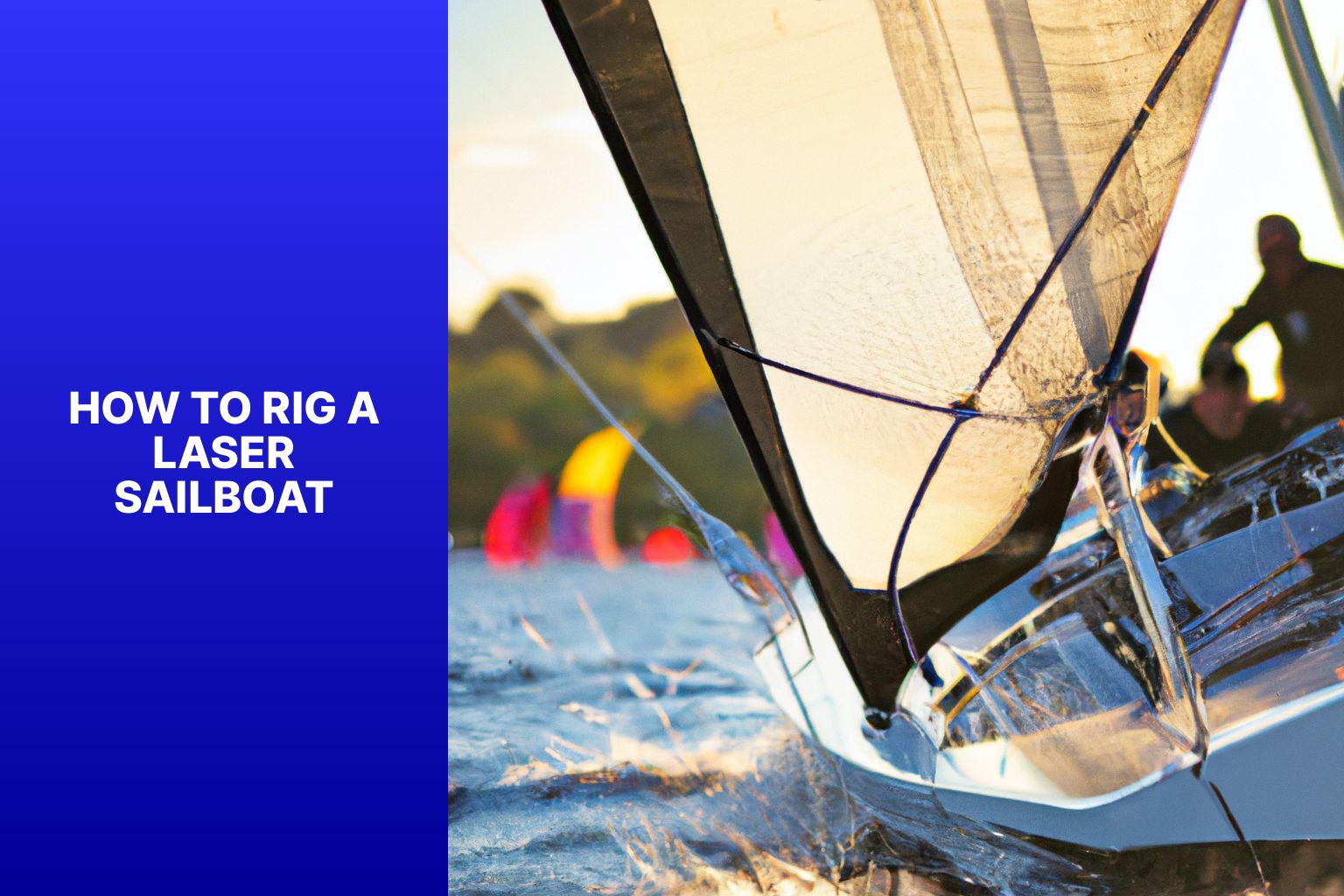
Rigging a Laser sailboat is an essential skill for anyone interested in sailing. Properly rigging a sailboat ensures that all components are securely in place, allowing for a safe and enjoyable sailing experience. This article will provide an introduction to rigging a Laser sailboat, explain the different components involved, and provide a step-by-step guide on how to rig the boat. It will offer tips and best practices to follow while rigging, as well as common mistakes to avoid. Whether you are a beginner or an experienced sailor, mastering the art of rigging a Laser sailboat is crucial for a successful outing on the water.
Key takeaway:
- Rigging a Laser sailboat requires understanding its components: The mast, boom, rigging lines, and sail are essential parts of a Laser sailboat rigging process.
- Following a step-by-step guide ensures proper rigging: Stepping the mast, attaching the boom, securing the rigging lines, and hoisting and adjusting the sail are necessary steps to rig a Laser sailboat correctly.
- Avoiding common mistakes and following best practices is crucial: To rig a Laser sailboat effectively, it is important to be aware of common mistakes and implement best practices for a successful rigging experience.
Understanding the Components of a Laser Sailboat
As we dive into the world of laser sailboats , it’s crucial to understand the nuts and bolts that make up these vessels. In this section, we’ll take a look at the key components that come together to form a laser sailboat . From the sturdy mast to the versatile boom , and the intricate rigging lines to the billowing sail , we’ll navigate through each element, unraveling their significance and how they contribute to a successful sailing experience. Get ready to explore the inner workings of laser sailboats and gain a deeper appreciation for their craftsmanship.
The mast is an essential component of a Laser sailboat as it provides vital support and stability to the sail. Constructed from either lightweight and strong carbon fiber or aluminum, the mast is designed to withstand the powerful forces of wind and water.
When rigging a Laser sailboat, the first crucial step is to carefully insert the mast into the mast step located at the base of the boat’s hull. Once inserted, it is important to raise the mast upright and secure it using a mast clamp or collar for stability.
The next important task is to attach the sail to the mast. This is achieved by raising the sail and securing it using halyards or sail ties. It is vital to properly tension the sail in order to optimize performance and maintain control while sailing.
Throughout the rigging process, it is imperative to regularly check the mast for any signs of damage or wear. It is essential to promptly address any cracks or weaknesses to ensure the safety of both the boat and the sailor while out on the water.
In order to prolong the longevity and enhance the performance of the mast, regular inspections, cleaning, and lubrication of the mast fittings are necessary. This will help prevent corrosion and ensure smooth operation during sailing sessions.
The boom is a necessary part of a Laser sailboat . It is a horizontal spar that extends from the mast. This sturdy pole controls the shape and position of the sail.
Attaching the boom is a crucial step in rigging a Laser sailboat . It involves sliding one end into a fitting on the mast called the gooseneck . The boom is secured with a boom vang , a line that runs from the mast to the boom . This vang controls the tension and angle of the boom , allowing sailors to adjust the sail’s shape and power.
Properly attaching and adjusting the boom is essential for efficient sailing. It allows the sailor to control the sail’s position and shape based on wind conditions. Adjusting the boom optimizes the sail’s power and performance, maximizing speed and maneuverability.
The use of booms in sailing has a long history. It originated from the use of horizontal spars to control the shape of sails on large sailing ships. Over time, booms have become an integral part of smaller sailboats, enhancing sailing performance and control. Nowadays, booms are used in various sailboat designs, including the Laser .
Rigging Lines
To properly rig a Laser sailboat, it is important to understand the components involved, including the rigging lines. Here are the steps to follow:
1. Begin by setting up the main halyard. Attach it to the head of the sail and run it through the top of the mast.
2. Next, secure the main sheet. Attach one end to the boom and run it through the blocks on the back of the boat.
3. Connect the cunningham line. Start by attaching one end to the cunningham eyelet on the front of the mast and run it through the block on the boom.
4. Establish the vang line. Attach one end to the vang fitting on the mast and run it through the block on the boom.
5. Attach the outhaul line. Connect one end to the outhaul fitting on the boom and run it through the outhaul block on the back of the boom.
6. Secure the traveler line. Attach one end to the traveler block and run it through the block on the back of the boat.
By following these steps, you can effectively rig the rigging lines on a Laser sailboat. It is important to check the lines for wear or damage before sailing to ensure a safe and enjoyable experience.
The sail is a crucial component of the Laser sailboat. It efficiently harnesses the power of the wind and propels the boat forward. The sail is carefully constructed using durable and lightweight materials, typically synthetic fibers like Dacron or Mylar .
The sail is securely attached to both the mast and the boom, forming a triangular shape that effectively captures the wind. The size of the sail plays a significant role in the boat’s overall performance. Sails of smaller sizes are ideal for lighter winds, whereas larger sails are more effective in stronger winds.
To properly rig the sail, it is important to securely attach the boom to the mast. Then, the sail should be hoisted up the mast, ensuring correct alignment and tension. The cunningham and outhaul lines can be adjusted to control the shape and tension of the sail.
Taking proper care and maintenance of the sail is crucial for its longevity and optimal performance. Prolonged exposure to direct sunlight should be avoided, as it can cause damage to the sail. Regular inspection for wear and tear is necessary, and any necessary repairs or replacements should be made promptly.
A well-rigged sail is essential for a successful sailing experience, allowing the boat to efficiently capture the power of the wind and maneuver through the water. By familiarizing yourself with the various components and following the correct rigging procedures, you can ensure that your Laser sailboat is ready for an exciting and rewarding adventure on the water.
Step-by-Step Guide on How to Rig a Laser Sailboat
Looking to hit the waves with your Laser Sailboat ? Mastering the rigging process is key to a successful sailing experience. In this step-by-step guide , we’ll walk you through the essentials of rigging a Laser Sailboat . From stepping the mast to hoisting and adjusting the sail, we’ve got you covered. Get ready to set sail with confidence and navigate the waters like a pro !
Stepping the Mast
To properly step the mast of a Laser sailboat, you should follow these steps:
- Position the sailboat upright on a flat surface, ensuring that the bow is facing into the wind.
- Securely insert the mast into the mast step.
- Lift the mast, bringing it into a vertical position.
- Make sure to fully insert the mast into the mast step, securing it firmly.
- Attach the mast base to the mast step by tightening the mast collar or locking mechanism.
- Ensure that the mast is straight and aligned with the centerline of the boat.
- If necessary, tighten any additional mast supports or stays to secure the mast further.
- Before moving forward with rigging the sailboat, double-check all connections to ensure they are secure and stable.
By following these steps, you can guarantee that the mast is properly stepped and securely fixed, providing a strong foundation for rigging the rest of the Laser sailboat.
Attaching the Boom
To attach the boom to a Laser sailboat , follow these steps:
1. Position the boom near the mast , aligning the gooseneck with the mast slot .
2. Slide the boom all the way through the mast slot .
3. Align the holes on the boom fitting with the holes on the mast fitting .
4. Insert the boom bolt through the holes and securely fasten it with a nut if needed.
5. Check that the boom is securely attached and moves smoothly along the mast .
True story: When rigging my Laser sailboat for the first time, I struggled to align the boom fitting with the mast fitting . After a few attempts, I realized I needed to adjust the boom’s position slightly for proper alignment. Once adjusted, the boom slid into place smoothly, and I secured it with the bolt . This experience taught me the importance of attention to detail when rigging a sailboat.
Securing the Rigging Lines
To secure the rigging lines on a laser sailboat, follow these steps:
- Attach the main halyard to the head of the sail.
- Secure the Cunningham line to the front of the mast.
- Attach the outhaul line to the clew of the sail.
- Secure the downhaul line to the tack of the sail.
- Double-check the security of all the rigging lines and make any necessary adjustments for proper tension and alignment.
- Engage the cleats or other fastening mechanisms for the rigging lines to prevent slippage during sailing.
- Check all the rigging lines again to ensure they are secure and properly tensioned before launching the boat.
By securing the rigging lines on a laser sailboat, the sail will be correctly positioned and tensioned for optimal performance on the water.
Hoisting and Adjusting the Sail
In order to hoist and adjust the sail properly, ensure that the halyard is properly attached to the sail and securely fastened . Stand towards the mast and pull on the halyard to raise the sail up the mast. Continue pulling until the sail is fully hoisted to the top of the mast, making sure there are no twists or tangles.
To achieve the desired sail shape based on wind conditions and personal preference, adjust the halyard tension. You can tighten or loosen the halyard to adjust the sail shape. Tightening the halyard will flatten the sail, while loosening it will add more depth .
For different wind conditions, make small adjustments and observe how the sail responds to find the optimal setting. Once the desired sail shape is achieved, secure the halyard by tying it off or using a cleat.
Let me share a true story: One time during a race, while I was hoisting the sail on my Laser sailboat, a sudden gust of wind caught the sail and caused it to billow dramatically . Fortunately, I quickly adjusted the halyard tension and regained control of the sail. This experience taught me the importance of properly hoisting and adjusting the sail to maintain stability and control on the water.
Tips and Best Practices for Rigging a Laser Sailboat
– Start with a well-maintained boat: Check for any damages or wear and tear that may affect the rigging process.
– Properly attach the mast: Use the mast step to securely attach the mast to the boat and ensure proper alignment.
– Attach the boom: Connect the boom to the mast using the gooseneck fitting and make sure it is securely fastened and aligned.
– Attach the mainsheet: Thread the mainsheet through the mainsheet blocks and tightly secure it to the boom for proper control while sailing.
– Attach the sail: Carefully center and align the sail on the mast, securing all sail ties to prevent it from coming loose.
– Tension the rigging: Optimize sailboat performance by adjusting the rigging tension to control the sail shape and maximize speed.
– Check all fittings and lines: Before setting off, inspect all connections to ensure they are secure and in good condition, including the halyard, vang, cunningham, and outhaul.
A sailor followed all the rigging steps meticulously, resulting in a well-rigged laser sailboat that effortlessly glided through the water during a regatta. Their attention to detail paid off as they sailed to victory, impressing their competitors with their skills and precision. This experience highlights the importance of following best practices and tips for rigging a laser sailboat to achieve success on the water.
Common Mistakes to Avoid while Rigging a Laser Sailboat
When rigging a Laser sailboat, it is important to avoid common mistakes that can negatively affect performance and safety. Here are some key points to keep in mind:
1. Correct sail positioning: Make sure to hoist and tension the sail properly. Incorrect positioning can result in poor trim and reduced speed.
2. Adequate rig tension: Proper tension is crucial for optimal performance. Avoiding insufficient tension will prevent a loose sail and decrease control.
3. Mast alignment: Always align the mast with the boat’s centerline. Deviation from this alignment can affect weight distribution and stability.
4. Efficient use of controls: Take the time to familiarize yourself with the cunningham, vang, and outhaul controls. Proper use of these controls will allow for adjustments to changing conditions.
5. Regular maintenance: Regularly inspect the rigging for any signs of wear or damage. Neglecting maintenance can lead to equipment failure and compromise safety.
By avoiding these common mistakes, you will enhance your sailing experience and ensure optimal performance. Remember to practice proper rigging techniques and comply with Laser Class rules.
Some Facts About How To Rig A Laser Sailboat:
- ✅ Rigging a Laser sailboat can be overwhelming for beginners, but with practice and guidance, it becomes easier. (Source: lasersailingtips.com)
- ✅ There is no specific order to rigging a Laser sailboat, as there are many combinations and methods. (Source: lasersailingtips.com)
- ✅ It is recommended to rig up a few times at home before heading out to ensure confidence and familiarity with the process. (Source: lasersailingtips.com)
- ✅ Before heading out, it is important to check the weather forecast and pack all the necessary gear neatly. (Source: lasersailingtips.com)
- ✅ The rigging process begins by laying the boom on the deck and feeding the mainsheet rope through the blocks and eyelets on the boom and cockpit. (Source: lasersailingtips.com)
Frequently Asked Questions
Faqs on how to rig a laser sailboat, 1. how do i assemble the mast of a laser sailboat.
To assemble the mast, slide the bottom of the top half into the top of the bottom half. Then, slide the sail over the mast using the pocket along one side of the sail. Insert the battens into the sail and ensure they are secured.
2. How do I attach the boom and rig the mainsheet?
Attach the front end of the boom to the gooseneck on the mast. Then, walk around to the flapping end of the sail while holding the boom on the gooseneck. Run the outhaul rope through the eye at the end of the boom and cleat it off. Rig the mainsheet by tying one end around the eye on the bottom of the pulley at the end of the boom and running the other end through the traveler on the stern of the boat, through the pulley on the end of the boom, and down through the main block at the front of the cockpit.
3. How do I stand up the mast and attach the boom vang?
To stand up the mast, carefully lift it and place it into the mast step at the front of the laser. Use the middle of the mast for better control and walk forward while pushing the sail up. As for the boom vang, attach it to the bottom of the mast and slide it into the metal clip on the bottom of the boom. Pull down on the hanging line and cleat it off.
4. How do I attach the rudder, tiller, and daggerboard?
Attach the rudder by inserting it into place and securing it with the tiller. Make sure the lift stop clicks into place. For the daggerboard, tie a long loop of elastic to the eye at the end of the dagger board and secure it to the boat.
5. What should I pack and check before rigging a Laser sailboat?
Before rigging, check the weather forecast and pack all necessary gear, including the sail, ropes, foils, and spars. Also, ensure that the hull plug is screwed into the drain hole in the stern of the boat. Check that you have a life jacket and other personal safety equipment.
6. How should I tidy up and secure the boat before launching?
Before launching, tidy up the area and ensure the boat is secure. If needed, detach the trailer or dolly from the car and position it close to the launch area. Double-check that all gear is packed and ready. When in deep water, always put on a rash vest and googles for added protection.
About the author
Leave a Reply Cancel reply
Your email address will not be published. Required fields are marked *
Save my name, email, and website in this browser for the next time I comment.
Latest posts

The history of sailing – from ancient times to modern adventures
History of Sailing Sailing is a time-honored tradition that has evolved over millennia, from its humble beginnings as a means of transportation to a beloved modern-day recreational activity. The history of sailing is a fascinating journey that spans cultures and centuries, rich in innovation and adventure. In this article, we’ll explore the remarkable evolution of…

Sailing Solo: Adventures and Challenges of Single-Handed Sailing
Solo Sailing Sailing has always been a pursuit of freedom, adventure, and self-discovery. While sailing with a crew is a fantastic experience, there’s a unique allure to sailing solo – just you, the wind, and the open sea. Single-handed sailing, as it’s often called, is a journey of self-reliance, resilience, and the ultimate test of…

Sustainable Sailing: Eco-Friendly Practices on the boat
Eco Friendly Sailing Sailing is an exhilarating and timeless way to explore the beauty of the open water, but it’s important to remember that our oceans and environment need our protection. Sustainable sailing, which involves eco-friendly practices and mindful decision-making, allows sailors to enjoy their adventures while minimizing their impact on the environment. In this…

- O’pen Skiff Purchase Page
- ILCA – Element 6
- RS Sailboats
- Sunfish – Recreational
- Sunfish – Race Version
- Sunfish Sails
- LaserPerformance Sunfish Parts Price List
- 420 – Zim Sailing
Finding the Right Laser Rig: Formula
- Racks by Dynamic Dollies and Racks
- Load Rite Trailers
- Load Rite Sunfish Trailer
- **NEW** LoadRite for Sailboats
- Sunfish Dolly by Dynamic
- Optimist Dolly by Dynamic
- How to Apply Laser Sail Numbers
- Applying Laser Sail Numbers
- North Sails for LaserPerformance Dinghies
- About/Contact
Choices of Rigs for your Laser Hull :

Finding the Right Laser Rig – 3 Choices:
Now this is where it becomes a bit interesting because all three rigs fit and work exceptionally well with the Laser hull. Any sized sailor can sail with one of these rigs in most conditions and have fun. But what if you are thinking competitively? What is optimal for you? The quick and simple formula is this:
- 4.7 Rig – Designed for smaller sailors 110 – 140 lbs. (50 – 65 kg).
- Radial Rig – Used as the women’s Olympic class, and designed for sailors 140 – 175 lbs. (65-80 kg).
- Full or Standard Rig – Used as the men’s Olympic class, and designed for sailors 165 lbs.+ (75 kg+).”Olympic sailors are in the 180 lbs. range but club sailors do well weighing in over 200 lbs. in certain conditions.” Paraphrased from propercourse.blogspot.com
Laser 4.7 Rig:
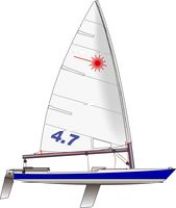
Laser Radial Rig:

A look at the hardware that changes the 3 rigs:
The Upper Mast section on the left side in this drawing is identical for all 3 rigs. It mates together with the other lower 3 mast section choices shown at the right. These parts are all available from Shoreline Sailboats along with class legal sails. The lower mast sections come with a gooseneck and vang tang; completely ready to go.
No matter which rig you choose, the Laser is a challenging boat that rewards athleticism, subtle steering, and trimming techniques, as well as tactical excellence.
Share this:
- Click to email this to a friend (Opens in new window)
- Click to share on Facebook (Opens in new window)
- Click to share on Twitter (Opens in new window)
- Click to print (Opens in new window)
- Click to share on Pinterest (Opens in new window)
- Click to share on LinkedIn (Opens in new window)
- Click to share on Tumblr (Opens in new window)
- Click to share on Reddit (Opens in new window)
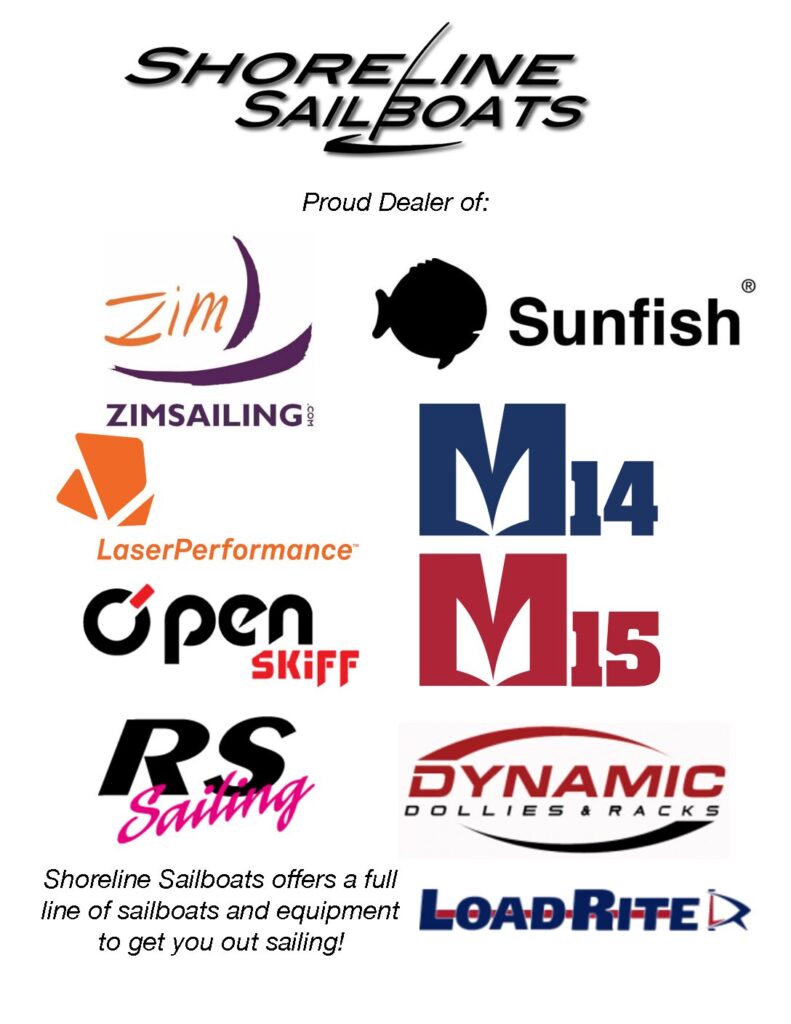
THE MELGES 15!
THE ROCKET! Built in the USA
SUNFISH – SAIL A CLASSIC!
Recent Posts

Hours & Info
Search products.
Contact us:
Any questions about the sailboats we sell, or the services we provide? We’re always eager to talk sailing and would enjoy helping you with any of your sailing needs. Contact Us
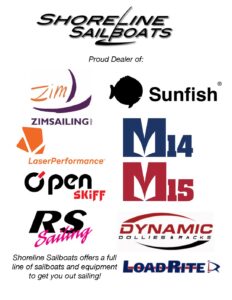
Designed by WPZOOM

How Long Is A Laser Sailboat?

Last Updated by
Daniel Wade
May 22, 2023
Key Takeaways
- A Laser is an ideal boat for those wanting to dinghy race or be active on the water
- Laser boats are 13.78 feet long and some use a smaller sail depending on your weight
- The Laser hull is an excellent dinghy design with a few sail modifications
- Laser sailors are able to transport the boat on a trailer or the top of a typical car
- Laser sailing is arguably the best dinghy since it utilizes an ideal weight and boat length
Laser sailboats are a popular racing dinghy that are compact and easy to handle. But how long is a laser sailboat?
A Laser sailboat is approximately 13.78 feet long and comes in three different rigging versions depending on your sailing needs. These boats include the Laser Standard, Laser Radial, and the Laser 4.7. Each rig type still remains just under 14 feet in boat length.
After careful analysis the Laser appears to have a perfect design and great boat length to accommodate any type of sailor no matter their experience. It is estimated that over 200,000 Laser boats are in about 140 countries and makes it the most popular racing dinghy out there.
Table of contents
Differences in Laser Boats
Laser boats all remain the same boat length of 13.78 feet so there will be a level of familiarity if you were to move from one rigging type to another. Since they are a one design boat they are typically the same style but newer models might have something that the older ones do not.
The only differences will be in the rigging that you choose upon your purchase. You can see the rigging types below and how they might apply to your skill and body type.
Laser Standard - Best All Around
The Laser Standard has a 76 feet squared sail and is meant for sailors that are more athletic or have a heavier build. The skill level ranges between beginner and expert but most adults with some sailing experience will opt for this rigging type.
Laser Radial - Best for Lighter Sailors
The Laser Radial has a 62 feet squared sail and is meant for women or lighter weight sailors. The skill level ranges between beginner and expert but most that have limited experience will likely choose this one.

Laser 4.7 - Best Beginner or Youth Sailing
The Laser 4.7 has a 50.59 feet squared sail and is best of youth sailors or lighter sailors in general. The skill level still ranges between beginner and expert but this is a perfect introduction into dinghy sailing for anyone.
The Charecteristics of a Laser Boat
A Laser boat is made up of many different parts. Each part makes the boat unique and is why it is able to be around 14 feet in length. If any one of these parts are damaged or missing you will not be able to experience the Laser as it was intended to be.
Mast Section and Boom
The mast is adjustable into two different parts. One of them being the shorter lower mast section and allows you to change direction based on the wind.
The boom is similar to the mast in that it helps control the angle of the wind hitting the sail. This is located at the bottom of the sail along the footing.
Various Types of Sails
The sails are any of the three types that were mentioned above. The size of your sails will depend on your personal weight so it is important for the right balance and performance to find the sails that are accommodating to you.
Stability with Daggerboard and Rudders
The daggerboard is a keel type that enters through a slot on the hull. This is essential for a boats stability. Rudders have to be down while sailing in order to properly steer the boat.
Steering with a Tiller
The tiller allows you to steer the boat through the rudder and is necessary if you want to sail. Most Laser boat racers opt for a tiller extender so that they can control the boat while leaning over the edge for balance.
Best Tips for the Purchase of a Laser Boat
Laser sailing is a one of a kind experience on the water and not meant for simple cruising. These boat types are used in the Laser World Championships and have their own Laser class among dinghy races throughout the world. They are governed by the International Laser Class Association and races have a set of Laser class rules.
Bruce Kirby and his innovation helped sketched and designed the first Laser boat in 1970. This paved the way for a revolutionary brand.
Since the earliest models it has gained a lot of popularity among dinghy sailing. Today you can still find some original Laser Standard sail and many newer models that could fit within your budget or sailing goals.
What to Look for in a Laser Boat
You could look to purchase a Laser boats based on a variety of factors. These could be new or used but will ultimately vary depending on the desired use.
If you happen to find an older Laser boat you should give it some thought. These boats are designed with the same hull type over the years and the quality has been consistent.
Hull’s Condition
The hull needs to be in good shape no matter if it is new or used. Make sure there are not any holes or spots that are soft which would later become a hole.
The hull weight should also be around 130 pounds since that is what new Laser boats are weighing. If used you should ask the owner how they stored the boat whether on land or left at a marina in the water.
Age of Laser
Laser boats can be great if they are taken care of over time. A 1970 version will obviously look and feel much different than a 2023 model.
A lot of models have the same hull and same specifications since they are a one design boat. If applicable you can check the hull number and look it up to get an accurate representation of the boats age.
Average Cost to Expect
Laser boats range in price depending on a variety of factors. If the boat was taken care of over the years then a used version will definitely be a the best bang for your buck.
A Laser boat that is used but in good condition could vary between $2,000 and $5,000. A newer Laser boat could start around $5,000 and be as high as nearly $6,000.
It is best if you can shop around to find a great deal on a Laser boat. Since there are over 200,000 Laser boats in regulation around the world the chances of finding one at a good price near you is highly likely.
Why You Might Consider Purchasing a Laser Boat
Laser boats are a great way to be active on the water and get a feel for sailing. The best thing about it is that you can have a good time without needing a ton of experience sailing beforehand.
Ease of Transportation
These are compact boats that can be easily transported by a truck or trailer. It would be best to transport with a trailer but not everyone has that capability. Some small cars can carry these if you can figure out a safe way to transport the boat.
Different Versions and Rig Setups
They make two different hardware versions and three different rigging types. Since the design is essentially the same over the years many sailors of different experience levels can work on their sailing skills.
XD is best for sailors wanting to find performance. Race is best for those wanting to sail recreationally or for racing in clubs.
Easy to Learn Sailing Skills
If you have never sailed on a boat like this then it will take some practice. There is a slight learning curve since you need to use your body to help balance the boat while racing. They are great for anyone with a competitive spirit and that love to go fast.
Related Articles
I've personally had thousands of questions about sailing and sailboats over the years. As I learn and experience sailing, and the community, I share the answers that work and make sense to me, here on Life of Sailing.
by this author
Learn About Sailboats
Most Recent

Affordable Sailboats You Can Build at Home
September 13, 2023

Best Small Sailboat Ornaments
September 12, 2023
Important Legal Info
Lifeofsailing.com is a participant in the Amazon Services LLC Associates Program, an affiliate advertising program designed to provide a means for sites to earn advertising fees by advertising and linking to Amazon. This site also participates in other affiliate programs and is compensated for referring traffic and business to these companies.
Similar Posts

Discover the Magic of Hydrofoil Sailboats
December 11, 2023

Hunter Sailboats: Are They Built for Bluewater Cruising?
August 29, 2023

What Is A Furler On A Sailboat?
August 22, 2023
Popular Posts

Best Liveaboard Catamaran Sailboats
December 28, 2023

Can a Novice Sail Around the World?
Elizabeth O'Malley
June 15, 2022

4 Best Electric Outboard Motors

How Long Did It Take The Vikings To Sail To England?

10 Best Sailboat Brands (And Why)
December 20, 2023

7 Best Places To Liveaboard A Sailboat
Get the best sailing content.
Top Rated Posts
Lifeofsailing.com is a participant in the Amazon Services LLC Associates Program, an affiliate advertising program designed to provide a means for sites to earn advertising fees by advertising and linking to Amazon. This site also participates in other affiliate programs and is compensated for referring traffic and business to these companies. (866) 342-SAIL
© 2024 Life of Sailing Email: [email protected] Address: 11816 Inwood Rd #3024 Dallas, TX 75244 Disclaimer Privacy Policy
- Articles and Guides
Small Sailboat Types: A Guide to Choosing the Perfect Vessel
9th mar 2023 by toi williams.

Learning how to sail can lead to years of fun and adventure, and having the right sailboat can make your experiences on the water even more enjoyable. Small sailboats have increased in popularity over the last few decades as more people have taken up sailing as a hobby, and today, many types of small sailboats are available for various types of activities.
So, what small sailboat types could be right for you?
Types of Small Sailboats
The term "small sailboats" encompasses a wide range of sailboat models. Generally, if a boat is less than 25 feet long and has a mast, rudder, and sail, it is considered a small sailboat. Various types of small sailboats have different characteristics that make them better for certain types of sailing. Here are some of the most popular small sailboat types.

Sailing dinghies
Sailing dinghies are frequently chosen because they are light and responsive. They are usually rigged with one mast and one sail, making them easy to handle, and they have a shallow draft, allowing them to be used almost anywhere. Sailing dinghies are also some of the least expensive sailboats because they tend to be simple with few features.
Laser – Laser sailing dinghies are nearly 14 feet long and weigh about 130 pounds, making them easy to maneuver and transport.
Beetle Cat - Beetle Cat sailing dinghies are roughly 12 feet long and have a draft of 2 feet, which makes them great for coastal cruising.
Sunfish - The Sunfish has a simple 14-foot setup and is ideal for those who want to learn how to sail.
Catalina 16.5 - The Catalina 16.5 is slightly over 17 feet long and can draft as low as 5 inches on the water.
RS Venture – The Venture model from RS Sailing is 16 feet long and is often used in training classes for those new to sailing.
RS Aero – The Aero model from RS Sailing is nearly 14 feet long and is known for its speed, making it popular with experienced racers.
Topaz Taz – At slightly under 10 feet in length, the Topaz Taz is one of the smallest sailing dinghies currently available.

Topaz Taz. Photo credit: Topper Saliboats
Daysailer is a broad categorization of small sailboat types based on usage and size. Daysailers, also known as dayboats, are larger than sailing dinghies and are available with or without sleeping accommodations. At Rightboat, we list a large selection of daysailers in a wide variety of styles.
Marblehead 22 – The Marblehead 22 is a daysailer with a cockpit that is nearly 12 feet long. It has plenty of room to seat several people.
Catalina 22 Sport – The Catalina 22 Sport daysailer is nearly 22 feet long, can sleep four people, and has a retractable keel for a draft of less than two feet.
Cape Cod Daysailer – This 16-foot sailboat is one of the most affordable models for its size and has enough room to seat several people comfortably.
West Wight Potter P19 – The P19 model from West Wight Potter is just under 20 feet long and comes with four berths, a galley, a sink, and a stove.
Sun Cat – This daysailer from Com-Pac Yachts is nearly 18 feet long and has twin 6-foot berths as well as a handful of other useful amenities.

Photo credit: Zurn
Small sloops
Small sloop is another popular category of small sailboat types. These sailboats are easy to maintain and easy to learn to control and maneuver. They are characterized by a single-mast rig, which typically has a triangular mainsail and a headsail. Small sloops can usually be sailed with one to four people aboard and can be used for all types of sailing in different conditions.
Montgomery 17 – This small sloop has a length of roughly 17 feet and a retractable centerboard keel that can make the boat draft just 2 feet.
Super Snark - The Super Snark is 11 feet long and weighs just 50 pounds with a payload capacity of about 310 pounds.
Flying Scot - At just under 20 feet in length, the Flying Scot is one of the larger small sailboats, allowing it to comfortably seat up to eight people.
BayRaider - The BayRaider is nearly 20 feet long with most of that space occupied by an open cockpit.
Small catamarans
Small catamarans are a good choice for sailors who want some extra stability on the water. These sailboats have two hulls that create a wide and stable base and can be rigged with one or two sails. Small catamarans are often used for cruising, fishing, and racing.
Hobie 16 - The Hobie 16 is slightly less than 17 feet long and is known for being fast, making it very popular with speed-loving sailors.
Minicat - Minicat has developed a line of inflatable catamarans with multi-piece masts that are available in various sizes.
More information: Buying A Sailing Catamaran

Photo credit: Hobie
Advantages of Small Sailboats
There are many reasons why you might prefer one of the small sailboat types over a larger model. Here are some of the most common reasons for choosing small sailboats.
Small sailboats are easy to sail
Small sailboats are often easier to sail because their rigging and steering are simpler. Small sailboats also react quicker to wind shifts, putting sailors more in tune with their surroundings.
Small sailboats are more affordable
The simplicity of small sailboats means you won't be paying a higher price for a bunch of features you don't need. If you choose to buy a certified used sailboat from our experts at Rightboat, you can save even more.
Small sailboats are easier to maintain
Maintenance needs for a small sailboat can be considerably less than what is necessary for their larger counterparts, saving you a significant amount of money over the life of your boat. The model and brand you choose are the biggest factors determining how easy it will be to maintain the boat.

Disadvantages of small sailboats
While there are a lot of things to like about small sailboats, they can also present some challenges in different types of sailing conditions. Here are some reasons why a smaller sailboat may not be the best choice for you.
Small sailboats sail slower
The smaller sails and hull of these types of sailboats make them go slower in the water when compared to larger sailboats. Unless a small sailboat is specifically designed for racing, do not expect it to travel very fast offshore.
Small sailboats have less space
While space is limited on all types of boats, this is especially noticeable with a small sailboat. This lack of space can make it difficult to plan extended trips without frequent stops to replenish your supplies.
Small sailboats have fewer comforts
Small sailboats are typically designed to be simple to launch and operate, so many of the comforts found on larger sailboats are absent on smaller models. In many cases, small sailboats do not have much seating and lack a galley for food preparation or a berth for sleeping.
Many factors go into choosing the right type of boat for your needs. While small sailboats are effective for a variety of purposes, they can present some challenges in certain conditions. At Rightboat, you can find the best boat for your sailing goals and your budget.
For more information check out our guide:
What are the Different Types of Sailboats?
Choosing the Best Beginner Sailboat
Written By: Toi Williams
More from: Toi Williams
Related Articles and Guides
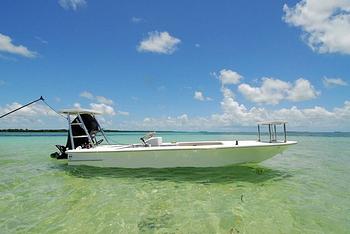
4th Mar 2024
The Best Flats Boats Brands, Special Boats for Skinny Waters
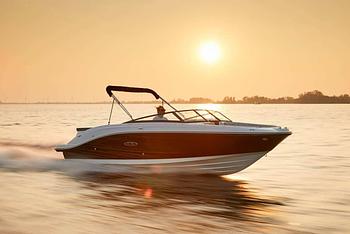
21st Feb 2024
Best Lake Boat Brands for Fishing, Cruising, and Watersports

15th Feb 2024
Best Aluminum Fishing Boat Brands: Tougher, Lighter and More Affordable
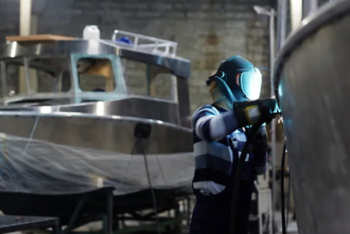
2nd Feb 2024
Aluminum vs Fiberglass Boats: Which is Best and Why?
- Explore Rightboat
- Boats for Sale
- Boating Articles
- Buyers Guide
- About RightBoat
- Sell Your Boat
- Boat Selling Advice
Enter your email to keep up to date with the latest news
Join for free
Sign up now for free and discover how easy it is to keep up to date with THE latest boats for sale. Find your right boat, and tailor your voyage to finding your next boat.
Benefits of becoming a member:
- Set up tailored alerts
- Personalise your experience
- Download full specifications and broker details
- Keep tabs on your favourite boats
Are you a broker? Join as a Broker
Rightboat - join for free.
Do you have an account already? Login
Save this search
Save your search and receive new boats in your email..
You can unsubscribe from your alerts whenever you like. By pressing the button you accept the Legal Terms and conditions
Last Updated on August 8, 2019 by Brendan
If you have been intrigued by the thought of owning and sailing your own dinghy, then it is high time for you to start looking at small sailboats so you can choose the one perfect for you. Whether you are infatuated with cruising or you are the more adventurous and enjoy the thrill of racing, there will be several things you need to consider when buying a boat, whether it is a laser sailing boat, or one of its counterparts. This article aims to give you some hints that might come in handy.
So what are the best small sailboats?

It is not a good idea to even think of buying one of the many different types of small sailing boats if you have not actually hit the water and experienced any for yourself. When it comes to boats, it is best to experience them first hand to see how they really work and perform, and to see if it is the perfect fit for you. Nothing beats actual experience when you want to evaluate the capacity and the power of a sail boat. It is also a good idea to see what the popular boats are in your local sailing club.
Several types of boats fall into the small sailboats category. Of course there are the dinghies (such as a laser sailing boat ) and the small yachts but even these two have so many different types to choose from. Generally, these types of boats are popular because they are not difficult to rig and easy to sail. Here are some of those which can be great choices for solo sailing or family fun.
These small dinghies are popular among those who are learning the basics of sailing. This boat is have been used in beginners’ classes in a lot of sailing clubs for decades because of their reliability and ease of use. They are great for kids to learn the basics in.
This is a single sail dinghy crafted in 1949 mainly for competitive sailing. Since its inception, it has maintained its reputation as an Olympic class and presently occupies the niche for the Heavyweight Dinghy. It also enjoys the title of longest standing sailing dinghy. For those who are really into competitive sailing then this boat would be a good choice. Sailors who have used it can attest to its excellent performance and competitive racing.
3. Melges 24

This is an excellent boat for tactical racing. This is usually sailed by 4 people and is professionally constructed with a lot of features necessary to racing. Its design boasts of a comfortable, light-hull displacement as well as its carbon fiber mast, bowsprit, vertical keel fin and rudder. It also has a 670- sq. ft. spinnaker which is asymmetrical, pulling and lifting boat forward when racing downwind.
4. Marblehead 22 DS
This type of small sailboats boat may have a traditional-looking hull but definitely has some high tech accessories. It has graceful lines but its body has a Hall Spars carbon-fiber mast with a wishbone rig and square-top main and a deep bulb keel.
5. Laser Sailing Boat

Lasers are Olympic class boats. They are single handlers and are loved by young and old sailors across the globe. It has 3 different sized rigs, allowing for different skill levels and weights. The laser sailing boat sails measures between 4.7 and 7.1 square meters, and the hull is 4.23 meters long and 1.37 meters wide. It weighs in at approximately of 60 kilograms.
These sailing vessels mentioned above are just a few examples of the small sailboats that you will find being sailed week in week out at clubs worldwide. However a diligent search on the internet or listening to what seasoned sailors recommend can give a new enthusiast a pretty good picture of what are the good ones and what to avoid. A laser sailing boat is one of the preferred choices among sailors but then there might just be some other types that you might find interesting. So take your time and weigh things up carefully, and study every detail of these small sailboats so you can find the best match that will answer your sailing needs.
Of all the small sailboats around, what’s your favorite?
So I’d love to know what sailing boat you are thinking of buying. Or if you already have one, what’s your favorite? Whether it is a laser sailing boat or not, please share what you think are the best small sailboats around.
More From My Site
About Brendan
Brendan has over 30 years experience sailing dinghies, yachts, and windsurfers, but has recently started Laser sailing. "I found it difficult to find all the information that I needed when I started sailing my Laser, and I am sure that others have had the same problem. So I combined all the information I could into this website to help other Laser sailors get the most out of this sport. If you have any questions or comments, let me know... I will get back to you as soon as I can."
Leave a Comment Cancel Reply

- Destination
Here’s All About The Laser Sailboat: Detailed Review
As the name suggests, the Laser sailboat is renowned for its zippiness and the thrill of speed. While one can categorize it as a dinghy, it is usually bigger and longer than a traditional one. With almost a quarter of a million boats produced globally since the 1970s, the Laser sailboat is easily one of the most popular types of sailboats, second only to the Sunfish.
About the Laser Sailboat
Prima facie, the Laser sailboat looks a lot like the Sunfish. However, the mechanics of a Laser boat are designed towards more speed and control. Even the body is more aerodynamic thus being able to utilize the upwind and downwind better. It is no surprise then, that the Laser boat is one of the most common race sailboats that you will find on the water. In fact, since the Atlanta Olympic Games in 1996, the Laser has featured regularly in the sailboat racing event.
However, the Laser is not all about speed. While it is lightweight, it handles superbly and has a very sturdy hull. The ease of operability makes it ideal for boaters just starting out in this great American pastime. Let’s check out some of the key features that make the Laser sailboat eternally popular among newbies and veterans alike.
Features of the Laser Sailboat
- Fiberglass hull for speed, durability and longevity
- Aluminum spars that keep the weight low while ensure it can withstand strong winds
- Fiberglass foils
- Harken Race upgrade Cunningham/Outhaul kit (in select models)
- Harken Race upgrade Boom Vang / Kicker (in select models)
- Gorilla tiller and extension for more flexible steering and enhanced maneuverability
- The official Laser Class legal Mark II sail
- 60mm Harken ratchet block that offers a strong yet comfortable grip
- Padded toe strap for the comfort and safety of the sailor
- Line kit for operating the sail
Laser Sailboat Specifications
Here are some details regarding the boat’s dimensions and other vital specifications:
* Features and specification may vary for the different variants such as Laser 2, Laser Pico, Laser Radial, etc.
Other Notable Aspects of the Laser Sailboat
The Laser is a customizable dinghy and the hull can accommodate rigs that are interchangeable and sail areas that differ accordingly. This is one of the several features that make it an easy to operate boat across different water and wind conditions.
Furthermore, the Laser is light and portable. This makes it rather easy to stow away and move around in a trailer-rig. Racing enthusiasts all over the world can be seen driving around with their Lasers while gathering for events, adding to the charm and the charisma of the atmosphere.
Another reason for its massive popularity is that it is one of the most affordable boats that you can hope to buy. Being a slim, bare, and a no-fuss boat, the Laser does not have expensive components or parts that add to its cost. It is a one-person operated vessel that costs less than most other types of boats and is low on maintenance as well. Due to its wide presence, it can be easily serviced across any boatyard or service center at nominal costs and there is usually a high availability of spare parts as well.
In Summation
Whether you’re a seasoned sailor or a beginner, if you like simplicity and speed, then the Laser sailboat is made for you. Its bare-minimum elegance and compact design helps it stand out among the crowd on the water while its peppiness helps you leave the crowd behind in a jiffy.
Recommended For You

Nomad Internet & Beacon Share is Helping Travelers Explore the World and Earn at the Same Time
Navigating language barriers: geneva airport transfers with multilingual drivers.

Choosing between a Hotel and a Cabin While Vacationing in the Smoky Mountains
Top benefits of professional flight training services.
About the Author: Teresa Sabo
Small Sailboat Types: Choose the Perfect One For You
A boat's weight, draft, and sail area often affect its performance in different wind and water conditions. For this reason, sailors often prefer small sailboats because they are easy to handle, have simple rigging and sail plans, and are also more affordable. In this article, we'll help you choose the perfect type of small sailboat that fits your experience and budget.
The most common types of small sailboats include dinghies, daysailers, sloops, and catamarans. Dinghies are small, lightweight boats that are easy to launch and sail, while daysailers are slightly larger but more comfortable. Sloops are characterized by a single-mast rig, while a catamaran has two hulls, which provide stability.
To choose the right small sailboat for your needs, there are three important factors to keep in mind: your skill level, the intended use of the boat, and your budget limits. Let's find out how each of these factors can affect your choice.
- Dinghies are lightweight and easy to transport, but they can capsize easily, have limited space, and are not suitable for long distances or overnight trips.
- Daysailers are more spacious than dinghies, but they are heavier and less maneuverable.
- Small sloops are more spacious and comfortable than dinghies or daysailers; however, they are heavier and more expensive and require a larger vehicle or trailer for transport.
- Small catamarans are fast and fun to sail but may require more maintenance and are less comfortable than sloops for overnight trips.
- If you plan to race, you may want a boat that is lightweight and fast, such as the J/70 or the Melges 24, but for day sailing, opt for small sailboats like the Hobie 16 or the Flying Scot.
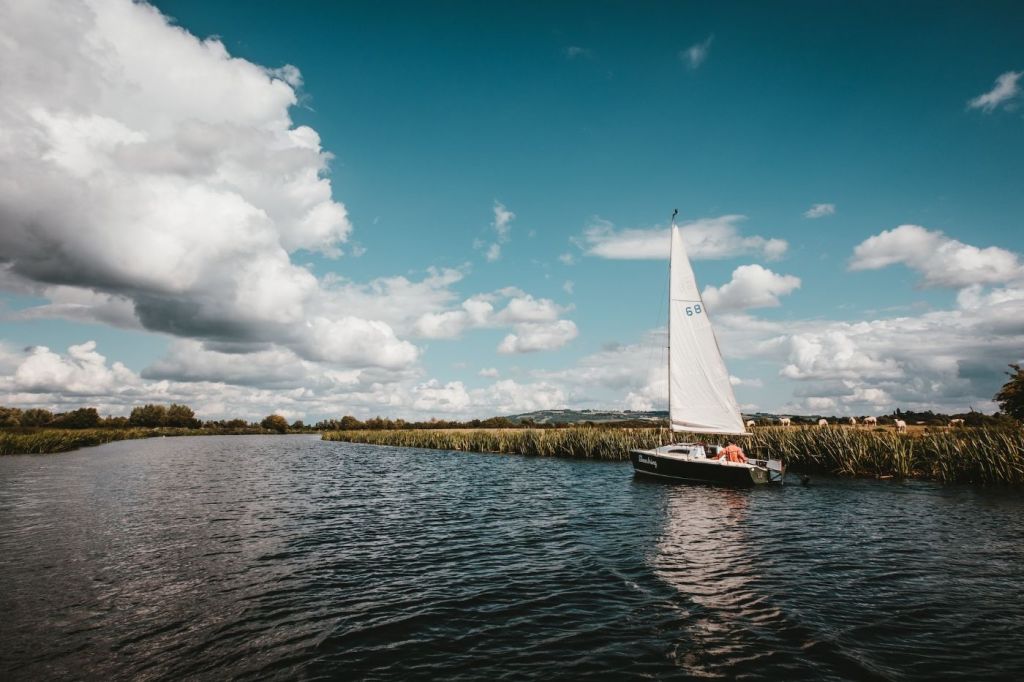
Types of Small Sailboats
Below is a table showing the different types of small sailboats and a short list of popular sailboats under each one:
Dinghy is a common type of small sailboat
A dinghy is a small sailboat that is typically used for racing or sailing in shallow water. It can be sailed by one or two people, and they are usually very lightweight and easy to handle.
They also cost less compared to other types of small sailboats. If you're curious as to how much a dinghy costs , here's an article for you.

They are also very versatile and can be used for a variety of different sailing activities. Here are the pros and cons of choosing a dinghy:
- Pros: Lightweight and easy to transport, great for racing, maneuverable, good for learning basic sailing skills.
- Cons: Can capsize easily, limited space for passengers, not suitable for long distances or overnight trips.
To know which type of dinghy suits you best , you can read this article.
Daysailers are another popular small sailboat choice
Daysailers are slightly larger than dinghies and are designed for day sailing. They are usually between 16 and 20 feet in length and can be sailed by two or more people.
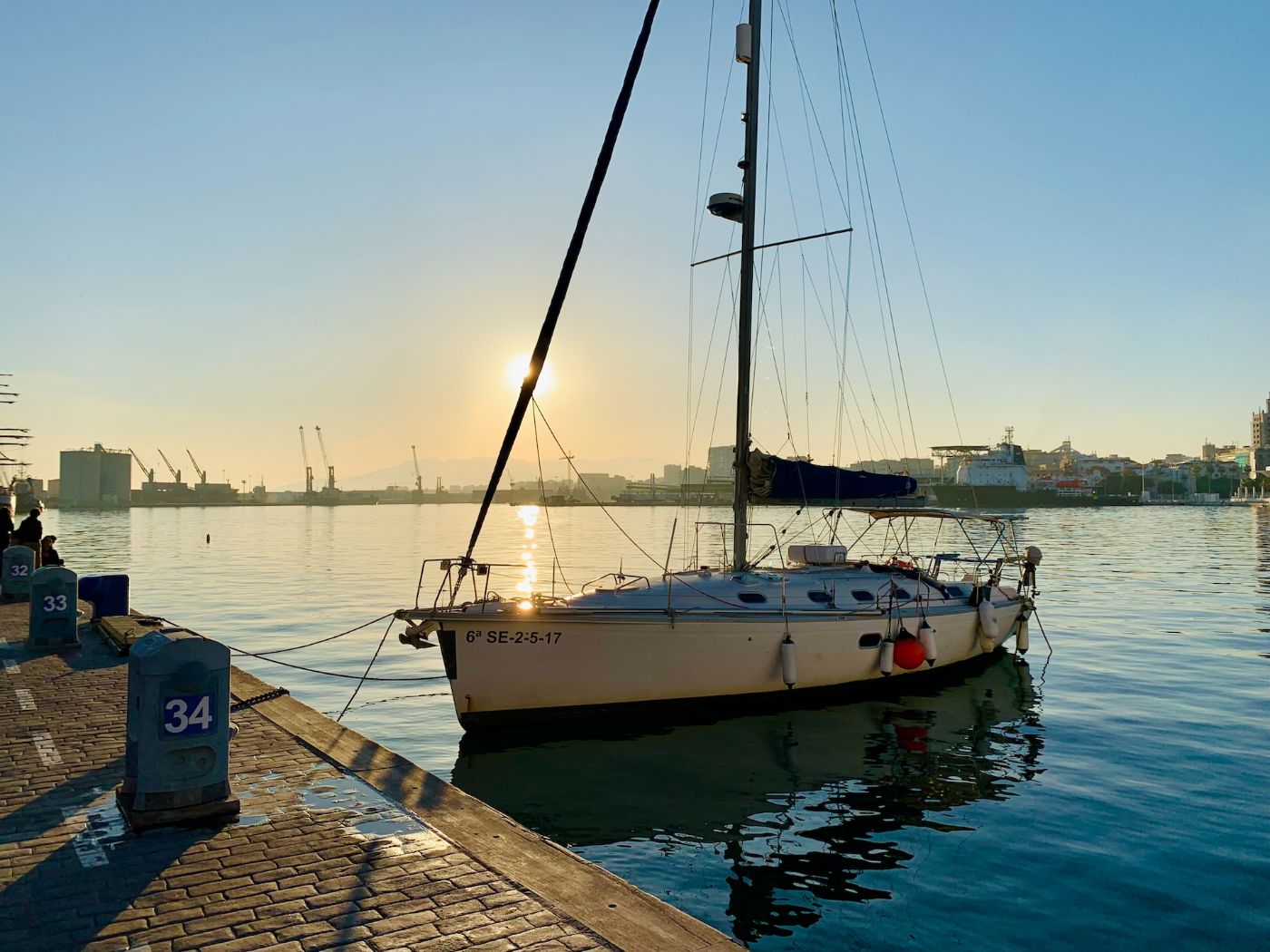
Daysailers are designed for comfort and ease of use, with features such as a small cabin or cockpit for shelter and storage. They are also often equipped with amenities such as a small galley or a portable toilet.
- Pros: More spacious than dinghies, can accommodate small groups, good for day trips and weekend outings, stable and easy to handle.
- Cons: Heavier and less maneuverable than dinghies, may require a trailer for transport, not suitable for long distances or overnight trips.
Small sloop is a classic and versatile small sailboat option
A sloop is a type of sailboat that has a single mast and a fore-and-aft rig. This means that the sails are set parallel to the centerline of the boat.
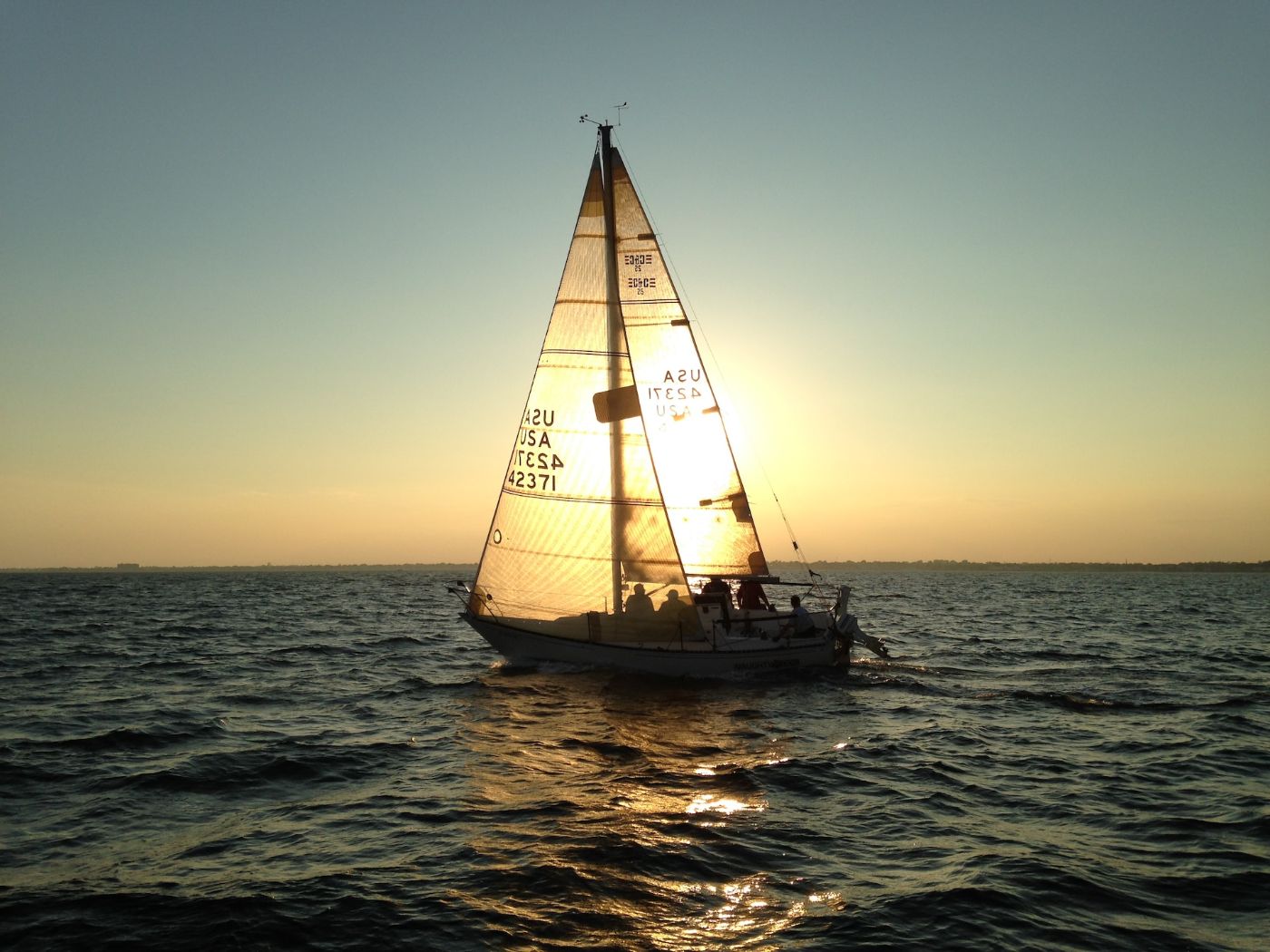
Sloops are one of the most popular types of sailboats because they are easy to handle and can be sailed by just one person. They are also very versatile and can be used for racing or cruising.
- Pros: More spacious and comfortable than dinghies or daysailers, can accommodate small groups, good for day trips and overnight trips, good for learning intermediate sailing skills.
- Cons: Heavier and more expensive than dinghies or daysailers, may require a larger vehicle or trailer for transport, may require more maintenance.
Small catamarans are a lightweight and stable small sailboat option
A catamaran is a type of sailboat that has two hulls instead of one. The hulls are connected by a trampoline, which provides a stable platform for sailing.
Catamarans are very fast and can be used for racing or cruising. They are also very spacious and can accommodate a lot of people.
- Pros: Fast and fun to sail, can accommodate small groups, good for day trips and weekend outings, stable and easy to handle.
- Cons: More expensive than dinghies or daysailers, may require a larger vehicle or trailer for transport, may require more maintenance, less comfortable than sloops for overnight trips.
If you want to know the costs of buying and owning a catamaran , either new or used, you might find this article helpful.
Small Sailboats for Different Skill Levels, Intended Use, And Budget
Below is a table showing how to choose a specific small sailboat model based on skill level, intended use, and budget:
Choosing the perfect small sailboat based on skill level
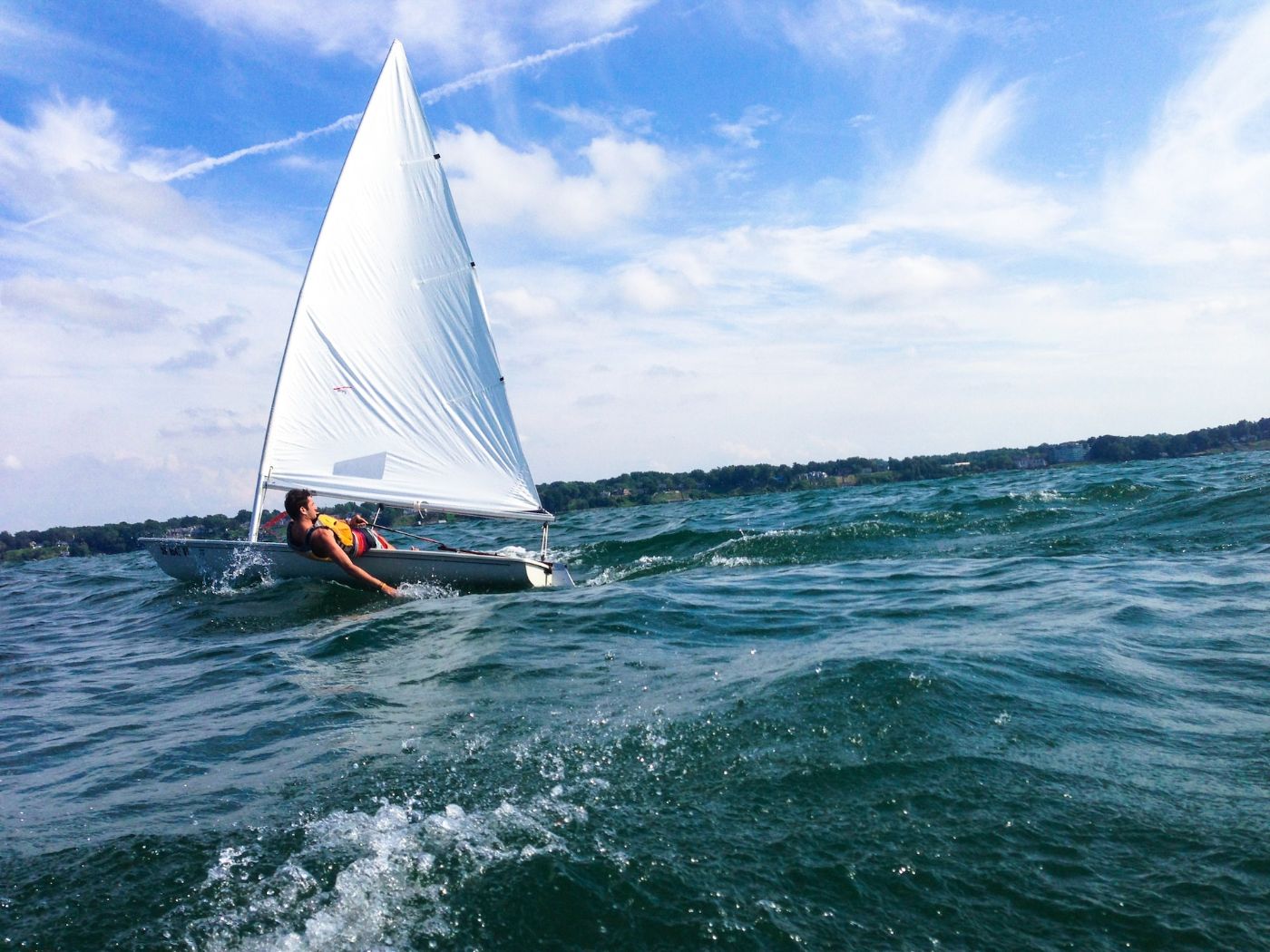
When choosing the perfect sailboat for you, try to choose a boat that matches your skill level so that you can enjoy sailing safely and comfortably.
Small sailboat for beginner sailors
If you are new to sailing, you may want to choose a small dinghy or daysailer that is easy to handle and control. Boats like the Sunfish or the Laser are popular choices for beginners, as they are lightweight and simple to rig.
These boats are also relatively forgiving, which means that they are less likely to capsize or cause injury if you make a mistake.
Small sailboat for intermediate sailors
If you have some sailing experience but are not yet an expert, you may want to consider a slightly larger boat that can handle more wind and waves.
Boats like the Catalina 22 or the Hunter 26 are popular choices for intermediate sailors, as they are larger and more stable than dinghies, but still relatively easy to handle. These boats also offer more amenities, such as a small cabin or a head, which can make them more comfortable for longer trips.
Small sailboat for advanced sailors
If you are an experienced sailor, you may want to choose a larger boat that can handle more challenging conditions. Boats like the J/105 or the J/120 are popular choices for advanced sailors, as they are designed for racing and cruising in open waters. These boats are more complex to rig and operate, but offer greater speed, stability, and control in high winds and waves.
Choosing the perfect small sailboat based on intended use
Are you planning to use the boat for day sailing, racing, or cruising? Different boats are designed for different purposes, so choose a boat that is well-suited for your intended use.
Small sailboat for day sailing
If you plan to use your boat for day sailing, you may want to consider a small dinghy or daysailer that is easy to launch and retrieve. Boats like the Hobie 16 or the Flying Scot are popular choices for day sailing, as they are fast and fun to sail in open waters. These boats are also relatively easy to rig and maintain, which makes them a great choice for recreational sailing.

Small sailboat for racing
If you plan to use your boat for racing, you may want to consider a lightweight and fast boat that is designed for speed and agility. Boats like the J/70 or the Melges 24 are popular choices for racing, as they are designed to be fast and responsive in all conditions. These boats are also highly maneuverable, which makes them a great choice for competitive sailing.
Small sailboat for cruising
If you plan to use your boat for cruising, you may want to consider a boat that is more comfortable and has more amenities. Boats like the Catalina 27 or the Hunter 31 are popular choices for cruising, as they offer more space, storage, and comfort than smaller boats. These boats are also designed to be stable and seaworthy, which makes them a great choice for longer trips.
Choosing the perfect small sailboat depending on your budget
Consider choosing a boat that fits within your budget so that you don't overspend and end up with a boat that you can't afford to maintain or use. The price for used dinghies ranges from $1,000 to $5,000.
For used sailboats within 20–40 feet, the prices range from $5,000 to $50,000 . Keep in mind that there are also additional costs to consider, such as storage, maintenance, and repairs.
To get an idea of the pricing for used sailboats , you can use this article as a reference. Meanwhile, for the annual maintenance costs for sailboats , here's an article you can refer to.
Leave a comment
You may also like, how much does a dinghy cost (with 14 examples).
Once we bought our first real "overnight" boat, we had a wake-up call when we realized that we weren't done with the spending. If we wanted to go anywhere but a …

Types of Dinghies: How to Pick the Right One For You

Average Cost of Buying & Owning a Catamaran (With 4 Examples)

Cost of Catamaran vs. Monohull: Which is more expensive?

Average Sailboat Insurance Cost in 2023 (13 Examples)
Own your first boat within a year on any budget.
A sailboat doesn't have to be expensive if you know what you're doing. If you want to learn how to make your sailing dream reality within a year, leave your email and I'll send you free updates . I don't like spam - I will only send helpful content.
Ready to Own Your First Boat?
Just tell us the best email address to send your tips to:

Laser RC Boats: Speed and Precision for Hobbyists
- By - Kyle Hilson
- Posted on November 14, 2023 November 15, 2023
- Posted in RC Boats
Remote-controlled boats have been a popular hobby for decades, but with advances in technology, the market now offers a wide range of sophisticated options. One of the latest innovations in the world of remote-controlled boats is the laser RC boat. These miniature boats use laser-guided technology to deliver precise and accurate movements on the water. The use of lasers has transformed the experience of remote-controlled boating, providing enthusiasts with improved speed, agility, and control. The boats operate using powerful batteries and motors and can effortlessly navigate through water, providing users with an exhilarating experience. The intricate designs of these boats pay attention to detail, with many models being replicas of real-life boats. Laser RC boats are suitable for both beginners and seasoned hobbyists, and with the continued evolution of the technology, we can only expect to see more exciting developments in remote-controlled boats.
Types of Laser RC Boats
There are several different types of laser RC boats available on the market, each with unique features that cater to different preferences and skill levels. Below are some of the common types of laser RC boats :
- Electric-powered boats: These boats use electric motors powered by rechargeable batteries. They are easy to maintain and are ideal for beginners.
- Gas-powered boats: These boats use gasoline engines and can be larger and faster than electric boats. They require more skill to operate and are suited for experienced hobbyists.
- Hybrid boats: These boats combine both electric and gas power systems, offering the best of both worlds. They are versatile and can be adapted to different needs and skill levels.
- Racing boats: These boats are specifically designed for speed and agility, with streamlined shapes and powerful motors. They are perfect for enthusiasts who enjoy competition and racing.
When shopping for a laser RC boat , it is important to consider the type of boat that best suits your preferences and skill level. Websites such as Amazon, HobbyKing, and RC Planet offer a wide range of laser RC boats in various configurations and price ranges. Some of the popular models of laser RC boats include the Pro Boat Blackjack, Volantex Vector , and Rage R/C Aqua Jet .
What type of Laser boats are there?
There are three recognized types of Laser boats: Laser Standard, Laser Radial, and Laser 4.7. The Laser Standard has a sail area of 7.06 m², Laser Radial has a sail area of 5.76 m², and Laser 4.7 has a sail area of 4.7 m². All of these boats have hull constructed from fiberglass. More information on Laser boats can be found on the International Laser website.
Advantages of a Laser RC Boat
Owning a laser RC boat offers several advantages over traditional RC boats. Below are some of the benefits of a laser RC boat :
- Efficient control: Laser technology offers precise control of the boat’s movements, making it easy to navigate through tight spaces and obstacles with ease.
- Makes boating safer: Since laser RC boats can be operated from a distance, it reduces the risk of accidents and injury compared to traditional boats.
- Fun and engaging: Laser RC boats offer a fun and engaging way to enjoy boating as a hobby, providing enthusiasts with an immersive and realistic experience.
- Easy to maintain: Laser RC boats are relatively easy to maintain, with simple cleaning and occasional battery replacements being the only necessary tasks.
- Environmentally friendly: Laser RC boats are environmentally friendly, emitting no emissions or negative impact on the environment and wildlife.
According to the International Laser Class Association , laser boats are considered one of the most popular boats worldwide, with over 200,000 boats in circulation. In addition to recreational use, laser boats are also used for competitive racing at various events around the world. Online stores such as Horizon Hobby and NitroPlanes offer a wide selection of laser RC boats in different sizes and configurations, ranging from affordable entry-level models to high-performance racing boats. The following table compares some of the popular models of laser RC boats :
Are lasers good boats?
Yes, the Laser is considered to be a good boat by many sailing enthusiasts. The Laser is a class of single-handed, one-design sailing dinghies that are popular for their common hull design with three interchangeable rigs. They are suitable for a range of wind strength and crew weight combinations. The Laser is one of the most well-known and accepted single-handed dinghies in the world, and many sailing aficionados love this sprightly little boat. More information about the Laser can be found on Wikipedia.
How to Choose a Laser RC Boat?
Choosing the right laser RC boat can be a challenging task, especially for beginners. Here are some essential factors to consider when selecting a suitable laser RC boat:
- Size: The size of the laser RC boat will determine its maneuverability and stability on the water. Smaller boats are easier to handle, while larger boats offer a more stable ride.
- Speed: The speed of the boat is determined by the motor’s power and size. Faster boats are usually more expensive and require additional experience in operating them.
- Battery life: Battery life determines how long the boat can run before needing a recharge. Boats with extended battery life will provide more time on the water.
- Durability: Look for a boat made from quality materials that is designed to withstand rough water conditions and crashes.
- Price: Laser RC boats are available in a broad range of prices, from under $50 to over $500. Consider your budget and level of experience when choosing a boat.
- Brand reputation: Research the brand reputation and look for customer reviews to ensure you are buying a quality product from a reputable manufacturer.
When selecting a laser RC boat , it’s also essential to consider the following related factors:
- Boat type: Different types of laser RC boats are available, including speed boats, sailboats, fishing boats, and more.
- Accessories: Check if the boat comes with the necessary accessories such as extra batteries, a charger, and a remote control.
- Skill level: Consider your experience and skill level in using a laser RC boat. Choosing a boat that matches your skill level is crucial to prevent frustration and accidents.
Online stores such as Amazon, HobbyKing, and Tower Hobbies offer an extensive selection of laser RC boats, making it easy to find a suitable model that matches your needs and budget.
Are Lasers good boats?
The Laser is a well-known and widely accepted single-handed dinghy in the world of sailing. It is considered to be a sprightly little boat that many sailing aficionados love. Learn more about its design and capabilities on websites like Wikipedia and through product information available online.
Where to Buy a Laser RC Boat?
There are several options for purchasing a laser RC boat , including online retailers and local hobby stores. Here are some popular places to buy a laser RC boat:
- Amazon: Amazon offers a wide range of laser RC boats with various brands, prices, and features. They also provide customer reviews and fast shipping to different locations.
- HobbyKing: HobbyKing is a popular online hobby store that specializes in RC toys and has an extensive selection of laser RC boats and accessories.
- Tower Hobbies: Tower Hobbies is a leading hobby retailer with over 40 years of experience and a vast selection of RC boats, making it easy to find the right laser RC boat for your needs.
- Local hobby stores: Check with local hobby stores in your area as they often carry a selection of laser RC boats and can offer guidance or repairs if needed.
If you are on a budget, consider purchasing a used laser RC boat from online marketplaces such as eBay or Craigslist . It’s essential to exercise caution and be prepared to inspect the boat thoroughly before completing the transaction.
Before purchasing a laser RC boat, ensure that the retailer offers reasonable return or refund policies in case the product is defective or damaged during shipping. It’s also important to check shipping fees and delivery times to ensure you receive your boat in a timely and cost-effective manner.
Are Laser boats still made?
Yes, Laser boats are still made. LaserPerformance now builds and sells a variety of racing and recreational sailboat dinghies, which include the Laser.
Maintenance and Repairs for Laser RC Boat
Maintaining a laser RC boat is crucial in keeping it functioning and increasing its lifespan. Here are some tips to maintain and repair your laser RC boat :
- Clean your boat after every use. This helps prevent damage to the body and internal components.
- Remove batteries from the boat when not in use. This prevents battery leakage and corrosion.
- Store your boat in a dry and safe location, away from direct sunlight or moisture.
- Use appropriate lubricants and oils to reduce friction and protect internal components.
If you encounter problems with your laser RC boat , here are some common issues and potential solutions:
If you don’t feel confident about repairing your laser RC boat , consider seeking help from professional services. Several websites offer repair services specializing in RC boats at affordable rates. Additionally, some hobby stores may offer repair services for a fee.
How do you maintain a Laser sailboat?
To maintain a Laser sailboat, you should always wash it with fresh water after a day of sailing. It is important to replace your ropes periodically and check your boat before and after sailing to ensure everything is secure and functioning properly. Bailer repairs and fixing leaks are also important maintenance tasks to keep your Laser sailboat in top condition. For more tips and products related to Laser sailboat maintenance, check out the Laser Performance website.
Laser RC boats have revolutionized the world of remote-controlled boats with their speed, accuracy, and durability. Owning a laser RC boat is not only an enjoyable hobby but also offers a fun and exciting way to spend time outdoors. By following the maintenance and repair tips provided above, you can ensure your boat stays in top shape and give you years of enjoyment.
When choosing a laser RC boat, take your time and consider your needs and preferences. With the right choice, you can enjoy endless fun and create new adventures. If you’re new to the hobby, do some research and read reviews from other enthusiasts to get an idea of what to expect.
In conclusion, Laser RC boats are perfect for anyone who loves water sports and outdoor activities. They have become a popular choice among hobbyists, and with proper maintenance, they can last for years offering hours of entertainment and adventure on the water. So why not give it a try? Choose your laser RC boat, follow the maintenance and repair tips, and enjoy all the fun and excitement that the water has to offer.

Previous Article
Next article.


IMAGES
VIDEO
COMMENTS
This is the most common Laser rig size, and the original rig on the boat when it was designed. It features a 7.06 square meter sail (about 76 square feet). In 2018, the Laser Class approved a new 'Standard' sail, which is referred to as the 'MKII' or 'Mark 2' to distinguish it from the first version. The difference, among other things, is in ...
Laser (dinghy) The Laser is a class of single-handed, one-design sailing dinghies using a common hull design with three interchangeable rigs of different sail areas, appropriate to a given combination of wind strength and crew weight. Ian Bruce and Bruce Kirby designed the Laser in 1970 with an emphasis on simplicity and performance.
The Laser has 2 hardware versions and 3 different rigs. Each uses exactly the same hull and foils, by lower mast and sail will make it suitable for a wide variety of sailors. This offers a unique step-by-step progression that makes it easy to switch models as a sailor change in age, ability or weight.
Thanks to the three rig sizes in the Laser class, the weight range in the Laser is quite large. Generally, the Laser Radial (ILCA 6) is suitable for sailors between 60kg and 75kg while the Laser Standard (ILCA 7) is suitable for sailors 75kg to over 90kg. The Laser 4.7 (ILCA 4) is designed specifically for younger and lighter sailors with an ...
The world's most popular adult and youth racing class. Originally known as the Laser, the ILCA dinghy is a single-handed racing dinghy. The biggest attraction of the ILCA dinghy is that it is protected by strict one-design class rules, which means that no changes are allowed to the boat unless they are specifically permitted in the rules.
The Laser is a popular sailboat due to its ease of rigging and sailing. A person sailing a Laser should be in good physical condition to handle the rigors of operating this vessel. ... There are a few different types of Lasers, but there are also separate classes for these boats, and they therefore must meet certain standards as well. ...
Over 200,000 Laser sailboats have been built over the last 40 years, more than most other small dinghy sailboats. ... The Laser sailboat has had a number of different rig sizes, with the intention of making the boat sailable by a wide range of sailors (and different sailor weights) by simply swapping out the lower mast section and sail while ...
1. Sailboat Number. Most dinghies have sailboat numbers on their cockpit's back or the deck. These numbers usually help to identify the age and quality of the sailboats. The newer ones tend to have the numbers etched on their cockpit's backs, while the older dinghies have these numbers written on their decks. 2.
The class ensures the one - design rules allow sailors to excel based on their ability to sail the boat, not the condition of the sails etc. This one design rule means that if a laser hull is maintained the resale value of a laser remains very high. The laser has a standard hull design with three different types of sails.
Introduction to Laser Sailing. April 3, 2018 Katie Olsen How To. by Jon Emmett. The Laser is truly the boat for all ages from our Junior 4.7s to our legendary (over 75 year old) Masters. No other adult class is raced in more countries in the World, in a class which takes grass roots to Olympic sailors. Come and join us to see why!
Learn more about the Laser sailboat. The Laser dinghy, designed by Bruce Kirby, was unveiled at the 1971 New York Boat Show. 200,000+ Lasers have been built since. Learn more about the Laser sailboat ... Exploring the Different Types of Sailing; The Top 7 Sailing Hats for 2023; Sailing Exercises: Improve Your Fitness For Sailing; Meta ...
The superb thing about the Laser is that it can be a boat for many different people and is especially a great boat for smaller youth sailors who will grow over time and can simply swap in and out the three different rig options. The rigs available are: Laser Standard - traditionally for men; Laser Radial - traditionally for lady and youth sailors
A laser dinghy is a small, single-person boat that uses a centerboard to control its direction. It is very similar to a Sunfish, which has been called the "poor man's sailboat" because it can be purchased for under $1,000 and sailed in freshwater lakes or ponds. Learning how to sail is easy with these two boats because they are simple ...
To properly rig a Laser sailboat, it is important to understand the components involved, including the rigging lines. Here are the steps to follow: 1. Begin by setting up the main halyard. Attach it to the head of the sail and run it through the top of the mast. 2.
4.7 Rig - Designed for smaller sailors 110 - 140 lbs. (50 - 65 kg). Radial Rig - Used as the women's Olympic class, and designed for sailors 140 - 175 lbs. (65-80 kg). Full or Standard Rig - Used as the men's Olympic class, and designed for sailors 165 lbs.+ (75 kg+)."Olympic sailors are in the 180 lbs. range but club sailors ...
Detach the Trailer/Dolly. If the trailer has to be detached from the car when parked, do this 1st. Then slide the dolly/trolley off the trailer, and position it relatively close to where you will launch, with the bow pointing into the wind. Laser dinghy on the dolly and trailer. Laser dinghy on the dolly, but off the trailer.
As a one-design class of sailboat, all International Lasers are built with the same hull specification of 4.19 m (13 ft 10.5″) length, with a waterline length of 3.81 m (12.5 ft), and a hull weight of 56.7 kg (130 lb), but there are now three association recognized types of Laser in the international racing class with smaller sail sizes to suit different weights and age of sailor.
A Laser sailboat is approximately 13.78 feet long and comes in three different rigging versions depending on your sailing needs. These boats include the Laser Standard, Laser Radial, and the Laser 4.7. Each rig type still remains just under 14 feet in boat length. After careful analysis the Laser appears to have a perfect design and great boat ...
Marblehead 22 - The Marblehead 22 is a daysailer with a cockpit that is nearly 12 feet long. It has plenty of room to seat several people. Catalina 22 Sport - The Catalina 22 Sport daysailer is nearly 22 feet long, can sleep four people, and has a retractable keel for a draft of less than two feet. Cape Cod Daysailer - This 16-foot ...
Lasers are Olympic class boats. They are single handlers and are loved by young and old sailors across the globe. It has 3 different sized rigs, allowing for different skill levels and weights. The laser sailing boat sails measures between 4.7 and 7.1 square meters, and the hull is 4.23 meters long and 1.37 meters wide.
With almost a quarter of a million boats produced globally since the 1970s, the Laser sailboat is easily one of the most popular types of sailboats, second only to the Sunfish. About the Laser Sailboat. Prima facie, the Laser sailboat looks a lot like the Sunfish. However, the mechanics of a Laser boat are designed towards more speed and control.
6-15 feet in length. Optimist, Laser, Sunfish, 420, 29er. Daysailer. Slightly larger sailboats that can accommodate small groups and are good for day trips and weekend outings. 16-20 feet in length. Catalina 16.5, Flying Scot, Precision 15, O'Day Daysailer. Small sloop.
When selecting a laser RC boat, it's also essential to consider the following related factors: Boat type: Different types of laser RC boats are available, including speed boats, sailboats, fishing boats, and more. Accessories: Check if the boat comes with the necessary accessories such as extra batteries, a charger, and a remote control.